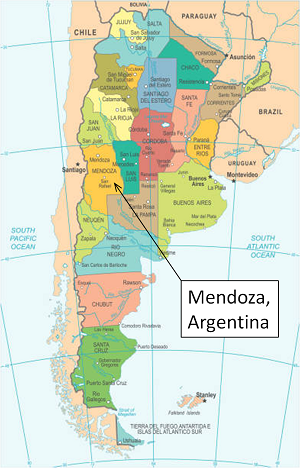Travel and Culture
If you're learning the Spanish language, chances are you've already experienced the attraction of the Hispanic culture and are looking for more! They say that everyone loves their home, whether they were born there or not. This is the feeling that sometimes results from travel to Spanish-speaking countries. Visit once and you're likely to return. Travel for a moment with us on this page.
-
The Argentinean Asado food & drink
-
Choripan food & drink
-
Chimichurri is the Best food & drink
-
Huitlacoche - the Caviar of the Aztecs food & drink
-
Street Food Latinoamérica food & drink
-
Mexican Pitayas food & drink
-
What are Totopos y Tostadas? food & drink
-
Más que Maíz food & drink
-
Empanadas - a Latin American Favorite food & drink
-
Have You Had a Calimocho? food & drink
- Cantabrian Bonito food & drink
- What is Yerba Mate? food & drink
- Try Chilean Pastel de Choclo food & drink
-
Chile's Food Labeling Law food & drink
-
Quinoa - the South American Superfood food & drink
-
Have You Tried Chipá? food & drink
-
Spanish Roulette food & drink
- Latin American Cuisine: Arepas food & drink
- La Frutería de Latinoamérica food & drink
- Casillero del Diablo food & drink
- Undiscovered Torrontés food & drink
- What is Malbec Wine? food & drink
- Carmenere – Lost and Found in Chile food & drink
-
Hispanic Holiday Traditions for the holidays
-
Celebrating Las Posadas for the holidays
-
Hispanic New Year's Eve Traditions for the holidays
-
Día de Reyes (Three Kings Day) for the holidays
-
Flor de Nochebuena for the holidays
Spanish Soccer (Fútbol) Vocabulary
 We hope you were able to watch and enjoy some of the 2022 Men's and 2023 Women's World Cup Soccer (Fútbol) games, and perhaps the Copa América and Copa Europa in 2024. While the popularity of soccer is modest in the U.S., calling the sport a passion in Spanish-speaking countries may be an understatement. If you know a native Spanish-speaker, just ask them something about the World Cup (La Copa Mundial) and you'll see. Better yet, if you can speak some Spanish, add some soccer vocabulary to your repertoire and use it! Or maybe you want to listen to a game with announcers speaking in Spanish. To help you out, we've listed some of the most commonly used soccer-related vocabulary below. This list doesn't have every word related to fútbol, but it'll get you started for sure. Vocabulary can differ by region or country, but we've included the most frequently used terms.
We hope you were able to watch and enjoy some of the 2022 Men's and 2023 Women's World Cup Soccer (Fútbol) games, and perhaps the Copa América and Copa Europa in 2024. While the popularity of soccer is modest in the U.S., calling the sport a passion in Spanish-speaking countries may be an understatement. If you know a native Spanish-speaker, just ask them something about the World Cup (La Copa Mundial) and you'll see. Better yet, if you can speak some Spanish, add some soccer vocabulary to your repertoire and use it! Or maybe you want to listen to a game with announcers speaking in Spanish. To help you out, we've listed some of the most commonly used soccer-related vocabulary below. This list doesn't have every word related to fútbol, but it'll get you started for sure. Vocabulary can differ by region or country, but we've included the most frequently used terms.
| The FIFA World Cup | La Copa Mundial de Fútbol |
| soccer | fútbol |
| soccer game | partido de fútbol |
| soccer ball | pelota, balón |
| playing field | cancha |
| team | equipo |
| player | jugador |
| substitute player | suplente |
| coach | entrenador, director técnico |
| referee | árbitro |
| goalie | arquero, portero |
| defender | defensor, defensa |
| midfielder | mediocampista |
| forward | delantero |
| fans | hinchas, aficionados |
| pass | pase |
| header | cabezazo |
| offside | adelantado, fuera de juego |
| the goal (net) | arco, valla, portería |
| a goal | gol |
| shot | disparo, tiro, remate |
| penalty | penalty, penal |
| yellow card | tarjeta amarilla |
| red card | tarjeta roja |
| first half | premier tiempo |
| halftime | medio tiempo |
| second half | segundo tiempo |
| a win | victoria |
| a defeat | derrota |
| a tie, draw | empate |
The next World Cup (2026) will be held in a number of cities in the U.S., Canada and Mexico.
How Do You Say 'bus' in Spanish? It depends.
Spanish if the official language in 21 countries. While the vast majority of the Spanish language is universal, things can get confusing when a word in English has several  Spanish translations, with usage depending on the country or region. Let's say you are visiting a Spanish-speaking country, and you want to travel by bus. How do you say 'bus' in Spanish? This everyday word is a messy example so we'll keep it simple. The most widely used translation is autobús. Use that and you'll probably be understood. Here are some other examples of other words used in the listed countries: bondi (Uruguay), colectivo (Argentina), micro (Chile), guagua (Cuba, Puerto Rico). Photo credit: primeraplus.com.mx
Spanish translations, with usage depending on the country or region. Let's say you are visiting a Spanish-speaking country, and you want to travel by bus. How do you say 'bus' in Spanish? This everyday word is a messy example so we'll keep it simple. The most widely used translation is autobús. Use that and you'll probably be understood. Here are some other examples of other words used in the listed countries: bondi (Uruguay), colectivo (Argentina), micro (Chile), guagua (Cuba, Puerto Rico). Photo credit: primeraplus.com.mx
What Does Guagua Mean and Where Did it Come from?
Perhaps you read our short article about some of the Spanish words for 'bus.' In Cuba, Dominican Republic and Puerto Rico, the word for bus is guagua is. Some say that this name came from English, since the first U.S. factory to export buses to Cuba was the Washington, Walton, and Company, who put the logo "Wa & Wa Co. Inc." on their buses. Since the 'W' in the Spanish language came in from other languages, maybe Wa-Wa did indeed become guagua due to the phonetic similarity.
Some say that this name came from English, since the first U.S. factory to export buses to Cuba was the Washington, Walton, and Company, who put the logo "Wa & Wa Co. Inc." on their buses. Since the 'W' in the Spanish language came in from other languages, maybe Wa-Wa did indeed become guagua due to the phonetic similarity.
In Argentina, Bolivia, Chile, Colombia, Ecuador, and Peru, guagua means a baby or infant. It comes from the Quechua word, wawa. Quechua is an indigenous language still spoken today by some who live in this region. At one time, small children could travel for free on the bus in Cuba, and Cubans would use the term to refer to free buses. Some think that evolved to become the word that means 'bus.'
No one knows for sure which of these theories is correct or how they might have evolved as they moved around geographically. Just keep in mind that what guagua means depends on where you are.
The Yucatan Peninsula of Mexico 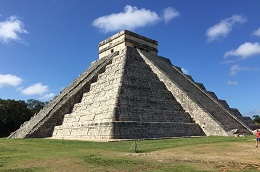 is well known for its beautiful beaches and turquoise seas. The resort city of Cancún is perhaps the best known but there are a host of locations to appeal to every taste. The region is also renowned for its Mayan archeological sites, including impressive restored ruins that draw many visitors. One of the most famous is Chichén Itzá, a UNESCO world heritage site and considered to be one of the seven wonders of the world.
is well known for its beautiful beaches and turquoise seas. The resort city of Cancún is perhaps the best known but there are a host of locations to appeal to every taste. The region is also renowned for its Mayan archeological sites, including impressive restored ruins that draw many visitors. One of the most famous is Chichén Itzá, a UNESCO world heritage site and considered to be one of the seven wonders of the world.
The geology of the Yucatan Peninsula consists largely of limestone (caliza). This rock is quite soluble, and the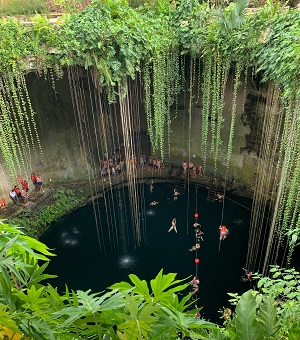 movement of water over millions of years has formed underground caves and large circular sinkholes with amazing pools of freshwater. The Spanish conquistadors called these sink holes "cenotes" (from a mishearing of the Maya word tz’onot). They are formed when the ground surface collapses into underground cavities, exposing the water table below. The limestone is so porous that there are no major rivers in the Yucatan Peninsula. Cenotes were the source of freshwater for the Maya, but were also of cultural significance. The Maya believed that cenotes were portals to a watery underworld inhabited by their ancestors and supernatural beings.
movement of water over millions of years has formed underground caves and large circular sinkholes with amazing pools of freshwater. The Spanish conquistadors called these sink holes "cenotes" (from a mishearing of the Maya word tz’onot). They are formed when the ground surface collapses into underground cavities, exposing the water table below. The limestone is so porous that there are no major rivers in the Yucatan Peninsula. Cenotes were the source of freshwater for the Maya, but were also of cultural significance. The Maya believed that cenotes were portals to a watery underworld inhabited by their ancestors and supernatural beings.
No trip to the area is complete without visiting and swimming in a cenote. While you can find photos of the archeological sites and cenotes online, there is nothing quite like experiencing them in person.
Vermont's Monarch Butterflies are Migrating to Mexico
In August, the monarch butterflies are in Vermont and laying eggs to produce the next generation. And it won't be long before those new butterflies begin their long journey to a place they have never been -- the Sierra Madre Mountains in Mexico! How can a butterfly that we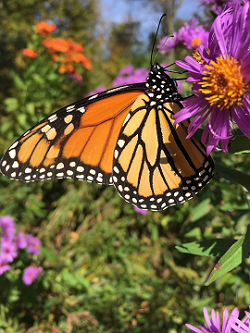 ighs half a gram make such a journey? While the earth's magnetic pull and the position of the sun are thought to help guide them, it still seems incredible! Every year, the monarchs arrive in Mexico very close to the Day of the Dead on November 1 (see our article, El Día de los Muertos). El Día de los Muertos is about remembering the lives of passed relatives and friends, and the butterflies have a cultural significance since, according to traditional beliefs of Michoacán’s Mazahua indigenous people, the monarchs hold the souls of the ancestors who return each year at this time. Sometimes the monarchs arriving in Mexico enter houses, suggesting even moreso that they may be visiting spirits.
ighs half a gram make such a journey? While the earth's magnetic pull and the position of the sun are thought to help guide them, it still seems incredible! Every year, the monarchs arrive in Mexico very close to the Day of the Dead on November 1 (see our article, El Día de los Muertos). El Día de los Muertos is about remembering the lives of passed relatives and friends, and the butterflies have a cultural significance since, according to traditional beliefs of Michoacán’s Mazahua indigenous people, the monarchs hold the souls of the ancestors who return each year at this time. Sometimes the monarchs arriving in Mexico enter houses, suggesting even moreso that they may be visiting spirits.
The monarch life cycle is truly amazing, and you can read more about it and see photos at monarchwatch.org. When spring comes in the south, the monarchs will start north but those we saw in Vermont last year will never return. They will reproduce in Texas or near there, and it is their offspring that will fly the rest of the way north to reproduce again. We are lucky to see them in Vermont every summer. That generation of monarchs seems to know when they need to leave, and in Vermont that's mid to late September. Enjoy them while they're here and wish them a safe journey!
(links in this article connect to other SWC articles)
The food that says "Argentina" more than any other is the asado. It's basically an Argentine barbecue but saying that alone sells it short. It is truly part of the Argentine culture, a social event centered around grilling various cuts of meat on an open outdoor grill called a parilla. The asador (the person in charge of the cooking) begins by carefully prepares the wood (leña) for the cooking fire, which is for the most part reduced to coals for the grilling. The hours it takes to do this and cook the mean combines perfectly with conversation and refreshments such as Malbec wine, cerveza (beer) or yerba mate.
So, this is not just a meal, it's more of a party. The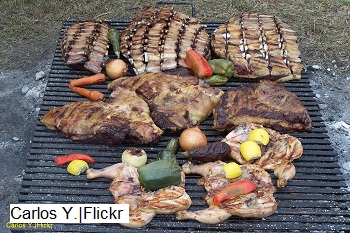 opportunity to slow things down and socialize with others is in itself an important part of Argentine culture. While an asado is frequently a backyard event with family or invited guests, it is also part of large events. The work of the asador is considered an art, and he (it's usually a man) does not labor alone. Others accompany him in conversation about cooking, the local fútbol (soccer) team or whatever.
opportunity to slow things down and socialize with others is in itself an important part of Argentine culture. While an asado is frequently a backyard event with family or invited guests, it is also part of large events. The work of the asador is considered an art, and he (it's usually a man) does not labor alone. Others accompany him in conversation about cooking, the local fútbol (soccer) team or whatever.
Argentine beef is world renowned and is usually the star of an asado, with pork, chicken and sausage frequently part of the mix. Choripan may be served as an appetizer because it's made with sausage that cooks much more quickly than some of the other cuts of meat. Other typical appetizers include morcilla (blood sausage), chinchulines (beef small intestine), mollejas (sweetbreads), empanadas, and provoleta (grilled provolone cheese). While an asado features meat, it usually includes side dishes such as salad, grilled vegetables and grilled potatoes. And of course, you'll find chimichurri, the yummy sauce used on meat, and by its fans, just about everything else.
A trip to Argentina should include an asado or a visit to an Argentine restaurant that does this kind of grilling. The word "parilla" is sometimes part of the restaurant name. This type of restaurant can also be found a number of US cities. If you're a meat lover, an asado should be on your bucket list.
Argentina is well known for its grilled meat, often served as part of an asado or a BBQ cookout/party. If you enjoy grilling, you owe it to yourself to try the flavor of Argentina with chimichurri sauce. Chimichurri is an uncooked, green sauce used on grilled meats and fish. And it’s so good that many also enjoy it on a piece of crusty bread. The main ingredients are parsley, garlic, oregano, olive oil, and vinegar, with the intensity of its flavor coming mostly from the fresh garlic and parsley. It’s easy to make and shouts FLAVOR! While you can find chimichurri sauce in bottles, it is way better when made with fresh ingredients. Go FRESH!
There are many recipes, with some including oregano or other spices. Here’s one that’s simple and yummy; the site also has other variations. https://www.food.com/recipe/chimichurri-21151
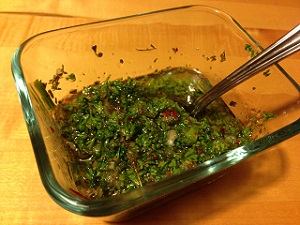
Chimichurri can be used as a marinade or applied to meat during grilling, but be sure to have some for use at the table as well (chances are that you’ll want to add more). Chimichurri is great with grilled beef, pork, and sausage. You should try it with Choripán - a sandwich made with sausage.
Choripán - the unofficial sandwich of Argentina
If you go to an asado in Argentina, there will certainly be chimichurri sauce available and probably also choripán. It's a sandwich made with sausage that was invented in Argentina, although similar sandwiches can be found in Bolivia, Chile, Guatemala, Peru, Puerto Rico, Uruguay and Venezuela. It's a classic street food, sold from roadside stands, at the fútbol (soccer) game during half time, at stands by the beach, and so on.  Choripán is a blend of the words chorizo and pan — sausage and bread — but that’s not all there is to it. Chimichurri is what makes the sandwich delicious. While typically made with Argentine chorizo, you can use most any sausage. Don’t use a strongly seasoned sausage as the chimichurri will give you more than enough flavor. Use a good piece of crusty bread such as a French baguette. Grill the sausage and then butterfly it by slicing lengthwise. If you can, also toast the roll a bit on the grill. Place the sausage in the roll, add a liberal amount of chimichurri and enjoy! It is common to also add salsa criolla, a South American salsa made with chopped bell peppers, onions, tomatoes, garlic, vinegar and olive oil. Some variations include the addition of oregano, parsley or cilantro. Here's a recipe for salsa criolla:
Choripán is a blend of the words chorizo and pan — sausage and bread — but that’s not all there is to it. Chimichurri is what makes the sandwich delicious. While typically made with Argentine chorizo, you can use most any sausage. Don’t use a strongly seasoned sausage as the chimichurri will give you more than enough flavor. Use a good piece of crusty bread such as a French baguette. Grill the sausage and then butterfly it by slicing lengthwise. If you can, also toast the roll a bit on the grill. Place the sausage in the roll, add a liberal amount of chimichurri and enjoy! It is common to also add salsa criolla, a South American salsa made with chopped bell peppers, onions, tomatoes, garlic, vinegar and olive oil. Some variations include the addition of oregano, parsley or cilantro. Here's a recipe for salsa criolla:
https://mediterraneanlatinloveaffair.com/argentinian-salsa-criolla/. Keep in mind that there are lots of different recipes that can be found online for both salsa criolla and chimichurri. Not a meat eater? Then try one of the meatless products such as 'Beyond Sausage' or 'Impossible Sausage'. Be sure to try choripán if your travels present the opportunity. Until then, give it a try at home. And don’t forget your favorite beverage, perhaps a microbrew or an Argentine Malbec.
Visit Dragonstone and Basque Country
If you watched HBO's Game of Thrones, perhaps you remember the scenes showing Dragonstone castle and the long rock stairway leading up to it (photo on the right). While you won't find the castle there, it was magically filmed on a real islet called Gaztelugatxe with a real path of 231 stone steps.  The photo on the left shows the island and the hermitage church at the top, as it is today. Gaztelugatxe is located near the Spanish city of Bilbao, in a region of Spain known as Basque Country. This is an amazing region to visit even if you don't go to Gaztelugatxe. It's both ancient and modern. You'll find cities with impressive architecture, fishing villages, mountains and amazing vistas, often all in close proximity.
The photo on the left shows the island and the hermitage church at the top, as it is today. Gaztelugatxe is located near the Spanish city of Bilbao, in a region of Spain known as Basque Country. This is an amazing region to visit even if you don't go to Gaztelugatxe. It's both ancient and modern. You'll find cities with impressive architecture, fishing villages, mountains and amazing vistas, often all in close proximity. 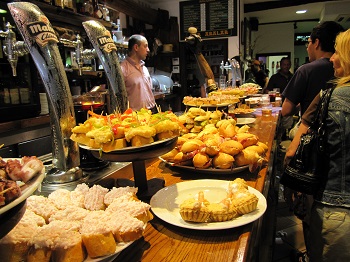 The food there is incredible; in San Sebastián, try the pintxos (pronounced pin-choss) which are finger-food morsels, often consisting of small slices of bread with toppings including meats, seafood, cheese or vegetables. You will find bars loaded with plates of pintxos. It's like a immense lunch buffet that you can choose from. And don't overlook the abundance of amazing restaurants. Interested in the beach? Playa de la Concha is one of the best city beaches in Europe.
The food there is incredible; in San Sebastián, try the pintxos (pronounced pin-choss) which are finger-food morsels, often consisting of small slices of bread with toppings including meats, seafood, cheese or vegetables. You will find bars loaded with plates of pintxos. It's like a immense lunch buffet that you can choose from. And don't overlook the abundance of amazing restaurants. Interested in the beach? Playa de la Concha is one of the best city beaches in Europe. 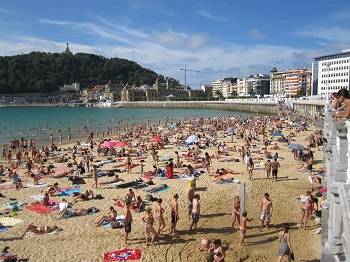 It can be crowded, but that only adds to the festive atmosphere. We've only scratched the surface of what this area offers, so you'll want to search out more online. Spain has so many amazing places to visit, and Basque Country is one of them! You may be interested in this guided tour of Gaztelugatxe and other nearby Game of Thrones filming locations. Swords and cloaks included!
It can be crowded, but that only adds to the festive atmosphere. We've only scratched the surface of what this area offers, so you'll want to search out more online. Spain has so many amazing places to visit, and Basque Country is one of them! You may be interested in this guided tour of Gaztelugatxe and other nearby Game of Thrones filming locations. Swords and cloaks included!
What is the Origin of the Spanish Language?
Where did the Spanish language come from? Perhaps ancient European history isn't your thing? That's OK, we'll give you the super-short version even though it's a long and complicated history. 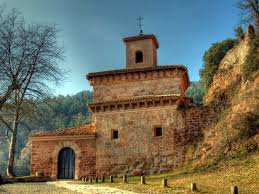 Centuries ago the Romans were conquering places all over Europe. They brought their language, Latin, to the Iberian Peninsula (the land mass occupied primarily by Spain and Portugal) beginning before the time of Christ. Of course, this area already had its own languages, including Arabic among others. However, the Roman influence lead to the development of "Castilian" Spanish. Spanish (as well as French, Italian and Portuguese) is a Romance language (this sounds romantic but it only means "derived from Latin"). Monks in the Suso monastery in La Rioja, Spain began translating sermons and prayers from Latin to Spanish in the
Centuries ago the Romans were conquering places all over Europe. They brought their language, Latin, to the Iberian Peninsula (the land mass occupied primarily by Spain and Portugal) beginning before the time of Christ. Of course, this area already had its own languages, including Arabic among others. However, the Roman influence lead to the development of "Castilian" Spanish. Spanish (as well as French, Italian and Portuguese) is a Romance language (this sounds romantic but it only means "derived from Latin"). Monks in the Suso monastery in La Rioja, Spain began translating sermons and prayers from Latin to Spanish in the  10th century, forming a written record of the language's origins and playing an important role in the development of the language. It is considered to be the birthplace of written Spanish. Today, Spanish is the official language in 20 countries and the second most widely spoken language in the world. Although Spanish is the official language of Spain, four other languages coexist with it are continue to be spoken in certain regions: Galician, Basque, Catalan and Occitan.
10th century, forming a written record of the language's origins and playing an important role in the development of the language. It is considered to be the birthplace of written Spanish. Today, Spanish is the official language in 20 countries and the second most widely spoken language in the world. Although Spanish is the official language of Spain, four other languages coexist with it are continue to be spoken in certain regions: Galician, Basque, Catalan and Occitan.
Huitlacoche - the Caviar of the Aztecs
What is it? First off, you'll probably need to travel to Mexico to find it. The name huitlacoche (pronounced whee-tla-KOH-cheh) comes from the Aztec language, Nahuatl. Known as "corn smut" by U.S. farmers, you may also hear it called "corn mushroom" or "corn truffle." It's a fungus, Ustilago maydis, that grows at the ends of maturing ears of corn. Sounds and looks gross but it is in fact a popular delicacy (manjar) in Mexico, dating back to the time of the Aztecs. Hence the nickname, "Caviar of the Aztecs."
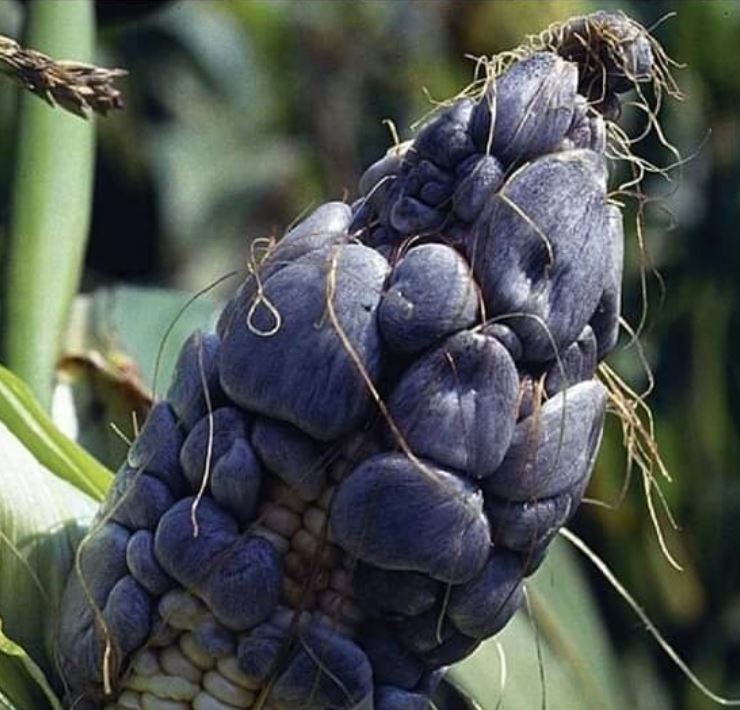
Huitlacoche is in season in Mexico from late spring to early autumn. It is usually consumed fresh and can be found at street markets and restaurants. It has a mushroom/corn taste that is also earthy and smoky. Huitlacoche is often sautéed with onions, chiles and cilantro, with the resulting fusion used to enrich everything from omelets to tacos to tamales. It can be used as a sauce with various meat dishes, but one of the most popular uses is to include it in a quesadilla made with cheese and topped with salsas.
If you have a chance while in Mexico, be sure to try it. If you are lucky enough to find it on your corn crop, don't throw it out! You can find more information online (for example, https://www.foodrepublic.com/2016/05/04/what-is-huitlacoche-and-how-do-you-cook-it/) about when it's ripe and how to cook it.
The Day of the Dead (El Día de los Muertos) is a holiday celebrated in Mexico and some other cultures, focusing on gatherings of family and friends to remember and honor those who have passed. The celebration takes place on November 1 and 2, in connection with the Catholic holidays of All Saints' Day and All Souls' Day. The origins of the holiday date back to an Aztec festival dedicated to the goddess Mictecacihuatl, the Lady of the Dead, but today is blended with Spanish Catholic beliefs. Traditions connected with the holiday include building private altars honoring the deceased, visiting graves and leaving gifts, as well as festivals with parades and dancing in colorful costumes and skull masks. As the sign in the photo below (from Texas) aptly explains, "It is a joyous occasion when the memory of ancestors and the continuity of life is celebrated. It is believed that at this time the souls of the departed return to visit the living. It is not a time of mourning since 'the path back to the living world must not be made slippery by tears.' "
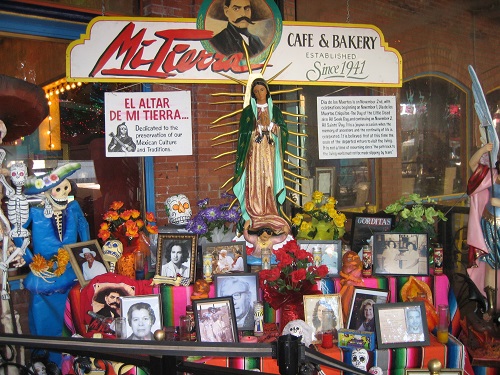
Catrina - Keeping the Spirits Alive
The Day of the Dead is a celebratory time to remember and honor loved ones who have passed on, and one of its most notable symbols is La Catrina. Where did this immortal icon come from?
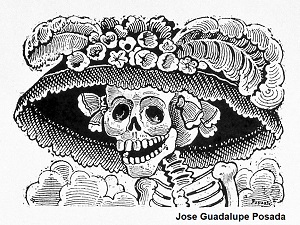 Mexico has a long tradition of honoring and celebrating the dead, dating back to the Aztecs. The mythology is that Mictecacihuatl, the Aztec Goddess of death, presided over festivals honoring the dead, and was often portrayed as a skeleton with a crown of flowers and skulls. Much later, Christian beliefs were superimposed on the persisting rituals.
Mexico has a long tradition of honoring and celebrating the dead, dating back to the Aztecs. The mythology is that Mictecacihuatl, the Aztec Goddess of death, presided over festivals honoring the dead, and was often portrayed as a skeleton with a crown of flowers and skulls. Much later, Christian beliefs were superimposed on the persisting rituals.
Inspired by the mythology of Mictecacihuatl, cartoonist Jose Guadalupe Posada drew "La Calavera Catrina," a caricature of an upper class Mexican woman drawn as a skeleton wearing a fancy French hat (circa 1910; above right). "Catrina" meant a well-dressed, wealthy woman. Posada was making fun of the upper 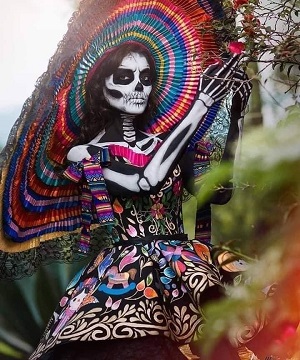 class Mexican ladies who used makeup to lighten their skin so as to look like wealthy Europeans. Posada's "La Calavera Catrina" played a role in the development of La Catrina as celebrated today.
class Mexican ladies who used makeup to lighten their skin so as to look like wealthy Europeans. Posada's "La Calavera Catrina" played a role in the development of La Catrina as celebrated today.
As part of the Day of the Dead celebration, Mexican women paint their faces to appear like skulls (calaveras) and dress in impressive, extravagant outfits and headwear. While Catrina is a woman, men often dress in similar calavera costumes. La Catrina confers messages about celebration, life and death, and accepting mortality without fear -- a destiny that applies equally regardless of societal position.
 This is the name of a new (2020) Netflix docuseries that you should definitely check out. As the name suggests, you'll see Latin American chefs preparing delicious offerings that blend cultural tradition and innovation. But this is far from being a cooking show. Each episode covers a different Latin country, thus far including Argentina, Brazil, Mexico, Peru, Colombia and Bolivia. You'll feel as if you're right there, experiencing the local food and culture in a vibrant way that tempts you to binge watch all the episodes. Caution: don't watch it if you're hungry. Do watch it to learn about the culture of each country, not just the food. Warning: you may want to visit these countries after seeing this series!
This is the name of a new (2020) Netflix docuseries that you should definitely check out. As the name suggests, you'll see Latin American chefs preparing delicious offerings that blend cultural tradition and innovation. But this is far from being a cooking show. Each episode covers a different Latin country, thus far including Argentina, Brazil, Mexico, Peru, Colombia and Bolivia. You'll feel as if you're right there, experiencing the local food and culture in a vibrant way that tempts you to binge watch all the episodes. Caution: don't watch it if you're hungry. Do watch it to learn about the culture of each country, not just the food. Warning: you may want to visit these countries after seeing this series!
The original audio is in Spanish but English audio is also available. Subtitles are available in Spanish, English and other languages.
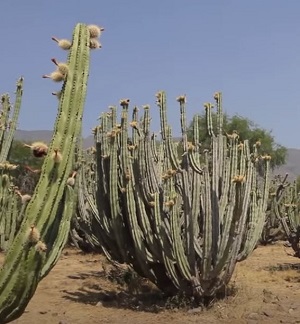 Mexico produces a number of special fruits and vegetables that you probably have not heard of because they are hard to find outside the country. One of these is the pitaya, a cactus fruit that is also known as dragon fruit. Different varieties of dragon fruit are also produced in other parts of the world (most dragon fruit sold in the U.S. are from Viet Nam); this article is about the pitaya of Mexico. The cacti are grown commercially for the pataya, and it's a big business especially in the state of Jalisco. In May, you can even attend a pitaya festival in the town of Amacueca.
Mexico produces a number of special fruits and vegetables that you probably have not heard of because they are hard to find outside the country. One of these is the pitaya, a cactus fruit that is also known as dragon fruit. Different varieties of dragon fruit are also produced in other parts of the world (most dragon fruit sold in the U.S. are from Viet Nam); this article is about the pitaya of Mexico. The cacti are grown commercially for the pataya, and it's a big business especially in the state of Jalisco. In May, you can even attend a pitaya festival in the town of Amacueca.
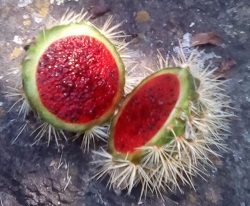 The pitaya is sometimes compared to kiwi fruit. It has tiny black seeds and flesh of various colors (red, orange, yellow, pink, white), each with its own distinct flavor. The season is between April and June. Its flowers bloom at night and are pollinated by moths or bats. Each flower lasts for just one night. When ripe, the fruit are harvested early in the morning to avoid the bright sunlight and provide enough time to get to market. Pitayas are picked from
The pitaya is sometimes compared to kiwi fruit. It has tiny black seeds and flesh of various colors (red, orange, yellow, pink, white), each with its own distinct flavor. The season is between April and June. Its flowers bloom at night and are pollinated by moths or bats. Each flower lasts for just one night. When ripe, the fruit are harvested early in the morning to avoid the bright sunlight and provide enough time to get to market. Pitayas are picked from 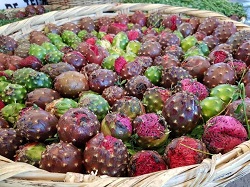 the tall cacti using a long pole. Their spiny covering is then removed with a knife, after which they must be handled carefully to avoid bruising. This 3-minute YouTube video shows how pitayas are grown, harvested, de-spined and sold. If you're in Mexico, or really any Latin American country, be sure to check for fruits or vegetables that are in season during your visit. They can be super good even though they may not be among the most famous dishes. We visited a smoothie shop in Chile that made some fantastic smoothies from fresh tropical fruit that you just can't get in snow country.
the tall cacti using a long pole. Their spiny covering is then removed with a knife, after which they must be handled carefully to avoid bruising. This 3-minute YouTube video shows how pitayas are grown, harvested, de-spined and sold. If you're in Mexico, or really any Latin American country, be sure to check for fruits or vegetables that are in season during your visit. They can be super good even though they may not be among the most famous dishes. We visited a smoothie shop in Chile that made some fantastic smoothies from fresh tropical fruit that you just can't get in snow country.
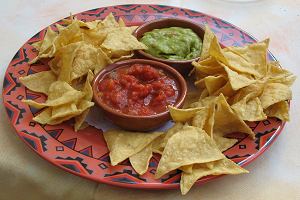 If your first language is English, chances are that you know totopos as tortilla chips. According to Wikipedia, a totopo "is a flat, round, or triangular corn product similar to a tortilla, that has been toasted, fried or baked." They date back to the Aztec period and originated in Mexican state of Oaxaca. The word totopo comes from the Nahuatl language and is a shortening
If your first language is English, chances are that you know totopos as tortilla chips. According to Wikipedia, a totopo "is a flat, round, or triangular corn product similar to a tortilla, that has been toasted, fried or baked." They date back to the Aztec period and originated in Mexican state of Oaxaca. The word totopo comes from the Nahuatl language and is a shortening 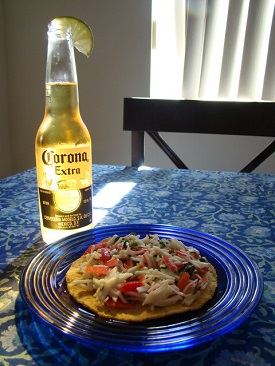 of the word tlaxcaltotopochtl. Tostadas are basically fried corn tortillas, round and usually about four inches across and a bit thicker than a totopo. They essentially serve as an edible platform to be loaded with any number of different of ingredients. The photo shows a ceviche tostada. Travel to Mexico and enjoy totopos and tostadas made that day, the way they should be.
of the word tlaxcaltotopochtl. Tostadas are basically fried corn tortillas, round and usually about four inches across and a bit thicker than a totopo. They essentially serve as an edible platform to be loaded with any number of different of ingredients. The photo shows a ceviche tostada. Travel to Mexico and enjoy totopos and tostadas made that day, the way they should be.
If we don't call guacamole or jalapeño by a name translated into English, then perhaps we should be saying 'totopos' instead of 'chips'. Start a trend and order 'guacamole and totopos' the next time you visit a Mexican restaurant.
Most students of Spanish know that maíz is the Spanish word for corn. However, corn was unknown in Europe until Columbus brought it back to Spain from the "New World" in 1493. 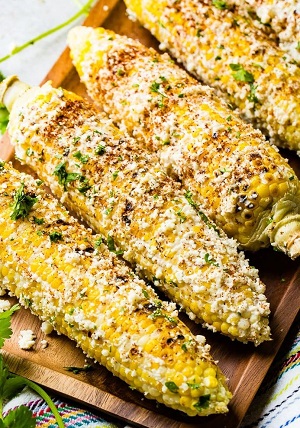 The Spanish word maíz came from the word mahiz of the Arawak language used in the Caribbean where Columbus landed. Other Spanish-speaking countries use other words for corn, derived from their own indigenous languages.
The Spanish word maíz came from the word mahiz of the Arawak language used in the Caribbean where Columbus landed. Other Spanish-speaking countries use other words for corn, derived from their own indigenous languages.
In Mexico and most of Central America, corn is elote. The word comes from the indigenous language Nahuatl. Grilled corn is a common street food and called elote asado, sold by eloteros. In South America the word for corn is choclo, derived from the Quechua word chuqllu. Quechua is an indigenous language from the Andes region of South America. In Venezuela, corn is called jojoto (origin unknown). Whether its elote, choclo or jojoto, they can mean corn on the cob or corn in a more general context. In Spain, corn is maíz and corn on the cob is mazorca de maíz.
One Hundred Years of Solitude Launches on Netflix
Netflix announced in March 2019 that it had acquired the rights to make a series based on the well known novel One Hundred Years of Solitude by Nobel Prize winner Gabriel García Márquez of Colombia.  The author died in 2014. His son Rodrigo Garcia indicated in a prepared statement, "For decades our father was reluctant to sell the film rights to ‘Cien Años de Soledad’ because he believed that it could not be made under the time constraints of a feature film, or that producing it in a language other than Spanish would not do it justice." The family felt that the quality of modern productions in the series format and the international viewership and acceptance of productions in various languages meant that the production could be done in a form that García Márquez would have supported.
The author died in 2014. His son Rodrigo Garcia indicated in a prepared statement, "For decades our father was reluctant to sell the film rights to ‘Cien Años de Soledad’ because he believed that it could not be made under the time constraints of a feature film, or that producing it in a language other than Spanish would not do it justice." The family felt that the quality of modern productions in the series format and the international viewership and acceptance of productions in various languages meant that the production could be done in a form that García Márquez would have supported.
So here we are. Netflix launched the first eight episodes on December 11, 2024, and a second season of another eight episodes is planned. The series is filmed in Colombia and produced in Spanish. Two of García Márquez’s sons are serving as executive producers.
The novel was first published in 1967 and has been translated into 46 languages and sold about 50 million copies. One Hundred Years of Solitude uses magical realism to tell the story of seven generations (100 years) of the Buendía family in the mythical town of Macondo. See how the family deals with love, sex, poltics and the inescapability of their fate. When you watch it, pay close attention as there is a lot to see and absorb.
Roma, Netflix’s Oscar-winning Movie
Whether or not you are studying Spanish, you should watch the movie Roma. Set in Mexico City's Roma district in the early 1970s, Roma chronicles the life of a middle-class family and its live-in maid (played by Yalitza Aparicio). Through a myriad of intimate yet subtle details that carry more meaning than may be initially apparent, the movie speaks volumes about life, class and cultural differences. Indeed, a second viewing may be required to pick up on everything. Many of our students have asked to talk about it as part of their class.
in the early 1970s, Roma chronicles the life of a middle-class family and its live-in maid (played by Yalitza Aparicio). Through a myriad of intimate yet subtle details that carry more meaning than may be initially apparent, the movie speaks volumes about life, class and cultural differences. Indeed, a second viewing may be required to pick up on everything. Many of our students have asked to talk about it as part of their class.
Roma won the following awards at the 2019 Oscars: Best Director, Best Cinematography, and Foreign Language Film. Nominated for seven other awards as well, many had expected the movie to also win the Best Picture Award. At the British Academy Film Awards, it did win Best Picture.
Released late in 2018 with a limited theatrical run, Roma is available via streaming on Netflix. The dialogue is in Spanish with some Mixtec (an indigenous language), and subtitles are available in English and Spanish.
Click the YouTube play button below to see the movie trailer.
International Women's Day and Social Justice
March 8 was International Women's Day, with a campaign theme that "a balanced world is a better world" (see internationalwomensday.com). This day does not seem to be as well known in the U.S. as in quite a few other countries. In our last email, we wrote about the movie Roma (read story) starring Yalitza Aparicio, an indigenous Mexican woman. She has rapidly become a role model for women's rights, especially in Mexico. Yalitza was born in the town of Tlaxiaco in Oaxaca, a state in southern Mexico. It's a town where most women work very hard, often seven days a week, to make a living and won't have the opportunity to see Roma. (Read more about working women in Tlaxiaco)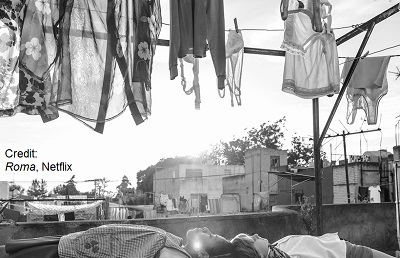
On March 8, Yalitza spoke on gender equality at the International Labour Organization (ILO) headquarters in Geneva, Switzerland. The ILO is a United Nations agency whose mandate is to advance social justice and promote decent work by setting international labor standards. She said that if you are women facing obstacles, you have to “keep insisting because at some point you will achieve it!” ("Si eres mujer, y si dicen que no, …sigue insistiendo porque en algún momento lo vas a lograr").
The website of the United Nations includes content both in Spanish and English. And is a good place to go for read in Spanish about human stories of global significance. Try these links and go from there:
https://news.un.org/es/news/topic/women women's articles, in Spanish https://news.un.org/en/news/topic/women women's articles, in English https://news.un.org/es/story/2019/03/1452451 UN article about Yalitza Aparicio, including a video interview, in Spanish
Have you ever wondered about why Hispanic 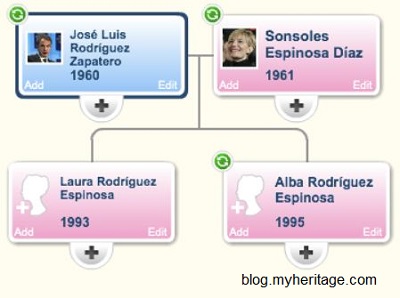 names are sometimes quite long, often including two or more surnames (last names)? As you study the Spanish language and culture, you have no doubt encountered examples. The historical tradition is for a child's first surname to be the father's first surname (apellido paterno), with the second surname being the mother's first surname (apellido materno). That's the case with Spanish actress Penélope Cruz Sánchez. Her father's first surname is Cruz and her mother's first surname is Sánchez. She likely uses this full name for legal matters but we know her as Penélope Cruz
names are sometimes quite long, often including two or more surnames (last names)? As you study the Spanish language and culture, you have no doubt encountered examples. The historical tradition is for a child's first surname to be the father's first surname (apellido paterno), with the second surname being the mother's first surname (apellido materno). That's the case with Spanish actress Penélope Cruz Sánchez. Her father's first surname is Cruz and her mother's first surname is Sánchez. She likely uses this full name for legal matters but we know her as Penélope Cruz  or perhaps Señora Cruz. As is the case here, it's a common practice today to use only one surname. Composite first names are also common in the Hispanic culture; for example, Juan Pablo.
or perhaps Señora Cruz. As is the case here, it's a common practice today to use only one surname. Composite first names are also common in the Hispanic culture; for example, Juan Pablo.
Andrés Manuel López Obrador was elected president of Mexico in 2018. His parents are Andrés López Ramón and Manuela Obrador González, with his first surname coming from his father and second surname from his mother.
That's the brief explanation. However, naming customs get more complicated than this and vary by country and region. To read more, try https://en.wikipedia.org/wiki/Spanish_naming_customs or https://en.wikipedia.org/wiki/Naming_customs_of_Hispanic_America
Empanadas - a Latin American Favorite
If you have travelled in Argentina, Chile, Colombia, Venezuela, Spain or a handful of other Latin American countries, chances are you have eaten empanadas. We say this because they are super popular, much like pizza is in the U.S.

According to Wikipedia, "An empanada is a type of pasty baked or fried in many countries of the Americas and in Spain. The name comes from the Spanish verb empanar, meaning to wrap or coat in bread." They originated in the northwest region of Spain, Galicia. It is hard to describe an empanada in more detail because their size, shape, dough, fillings and even cooking methods vary by country and region. Fillings include seafood, meat, cheese, vegetables or fruit, so there are some great choices for both veggie and meat lovers. In Argentina and Chile, a common filling consists of ground beef with pieces of hardboiled egg, onions and olives or raisins. A great meatless option is made with corn or with spinach and cheese. And the list goes on.
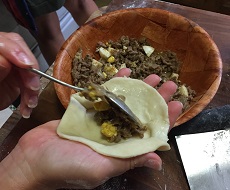 A great way to try empanadas is to visit one of the countries where they are popular, but authentic empanadas can be found in the U.S., including in Vermont (check online). You can also try making your own at home. In countries where they eat empanadas frequently, it is common to purchase a package of the discs (discos) of dough. That eliminates the work of preparing the dough. Here is a summary of how to make empanadas. More details can easily be found online.
A great way to try empanadas is to visit one of the countries where they are popular, but authentic empanadas can be found in the U.S., including in Vermont (check online). You can also try making your own at home. In countries where they eat empanadas frequently, it is common to purchase a package of the discs (discos) of dough. That eliminates the work of preparing the dough. Here is a summary of how to make empanadas. More details can easily be found online.
-
The dough is rolled out until thin and then cut out into round discs, roughly 5 inches in diameter.
-
The filling is prepared, including cooking depending on the ingredients. This is sometimes done prior to dough preparation.
-
The filling in placed in the disc, the disc is folded in half and the edge crimped closed.
-
Bake or fry.
-
Eat and enjoy.
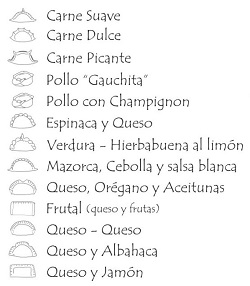
There are various artistic ways to do the crimp, and the process is called el repulgue de empanadas. The Spanish verb repulgar in this context means to crimp. This 1-min YouTube video shows one way to crimp an empanada. Because it is common in many Latin American countries to buy empanadas 'to take out' (para llevar), the stores fold the empanadas in different ways for the different fillings and give you a little graphic, like that shown at left, so you'll know which is which.
You can also buy empanadas locally, right here in Waterbury, Vermont, from the Paprika Catering Company. Their Argentinean empanadas are handmade and highly recommended. For more information, check them out at Facebook or email paprikacateringcompany@gmail.com.
Do Hispanics in the U.S. Speak Spanish?
This may be an unexpected question, and perhaps the answer is as well.
The U.S. population consists of about 2% Native Americans; the rest are immigrants and descendents of immigrants. Hispanics in the U.S. hail from about 20 different countries, but they share a common linguistic and cultural heritage. And, language is a big part of one's cultural identity. So, do U.S. Hispanics speak Spanish? Do they think that's it's important that their children speak Spanish? Is it necessary to speak Spanish to be considered Latino?
The answers to these questions are not simple. Hispanic immigrants that spoke Spanish prior to immigrating obviously spoke Spanish. However, speaking Spanish is still stigmatized by some in this country. Hence it is not surprising that Hispanics learn English and speak it in public, reserving Spanish for the home. Children have often been encouraged to do the same.
Most foreign born Hispanic immigrants speak Spanish to their children. Some kids learn the language while others are unreceptive. They are growing up in a country where almost everyone speaks English, and that's what they want to do. And then what happens when they have kids of their own?
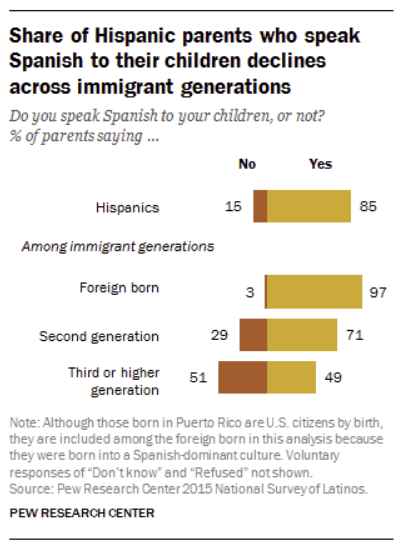
Clearly some parts of the U.S. have sizeable Latino populations while others such as Vermont are in the <1% category. The numbers cited above vary by region, as do opinions among Hispanics. In some places it seems like everyone is speaking Spanish. Where will we be after 10 more years?
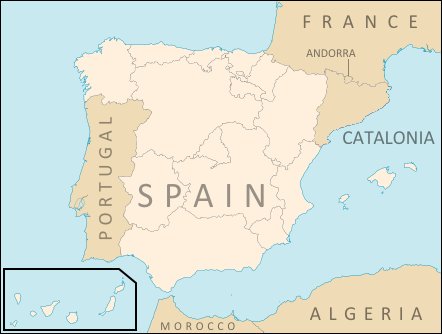 If On October 1, 2017 an independence referendum was held in Catalonia, a largely independent community located in the most northeast corner of Spain. While Catalonia is part of Spain, it has its own history, culture and language. The Catalan independence movement has been all over the news, so we are taking this opportunity to say a few words about Catalan. It's one of the official languages in Catalonia and something visitors to Barcelona run across. What is the difference between Catalan and Spanish? Catalan is not a dialect of Spanish. While they share some vocabulary, grammatical structure, and expressions, they are separate languages. Some say Catalan sounds like a mix of French, Italian and Spanish, perhaps more like the first two. All are Romance languages sharing a common derivation from Latin, and are similar but distinct. If you speak Spanish, you should be able to understand a Catalan speaker.
If On October 1, 2017 an independence referendum was held in Catalonia, a largely independent community located in the most northeast corner of Spain. While Catalonia is part of Spain, it has its own history, culture and language. The Catalan independence movement has been all over the news, so we are taking this opportunity to say a few words about Catalan. It's one of the official languages in Catalonia and something visitors to Barcelona run across. What is the difference between Catalan and Spanish? Catalan is not a dialect of Spanish. While they share some vocabulary, grammatical structure, and expressions, they are separate languages. Some say Catalan sounds like a mix of French, Italian and Spanish, perhaps more like the first two. All are Romance languages sharing a common derivation from Latin, and are similar but distinct. If you speak Spanish, you should be able to understand a Catalan speaker.
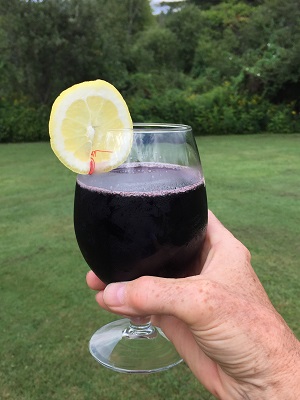
Despacito has Everyone Singing in Spanish
 Chances are you've heard the hit song Despacito by Latino artists Luis Fonsi and Daddy Yankee, both from Puerto Rico. The song's catchy rhythm has made it the most-streamed in history and earned it the number one spot on Billboard's Hot 100. With over 3 billion views on YouTube, it is also the most viewed video in the history of YouTube. That's especially impressive given that the song is in Spanish and a cultural crossover. However, it is now an international hit that exists in many languages.
Chances are you've heard the hit song Despacito by Latino artists Luis Fonsi and Daddy Yankee, both from Puerto Rico. The song's catchy rhythm has made it the most-streamed in history and earned it the number one spot on Billboard's Hot 100. With over 3 billion views on YouTube, it is also the most viewed video in the history of YouTube. That's especially impressive given that the song is in Spanish and a cultural crossover. However, it is now an international hit that exists in many languages.
The song's mention of Puerto Rico plus scenes in the video have generated a lot of interest in travel to the island. People want to see "how we do it down in Puerto Rico" (a phrase from the song, translated into English). Travel-booking websites have seen an increase in search related to Puerto Rico, and increased tourism would certainly help this U.S. territory a bit with its economic difficulties.
So here's the only link you need: The ‘Despacito’ Lyric Guide That Every Non-Spanish Speaker Needs. Here you'll find the original video, a video of Luis Fonsi explaining the song and its lyrics, and the lyrics written in both Spanish and English, verse by verse. (08/07/2017)
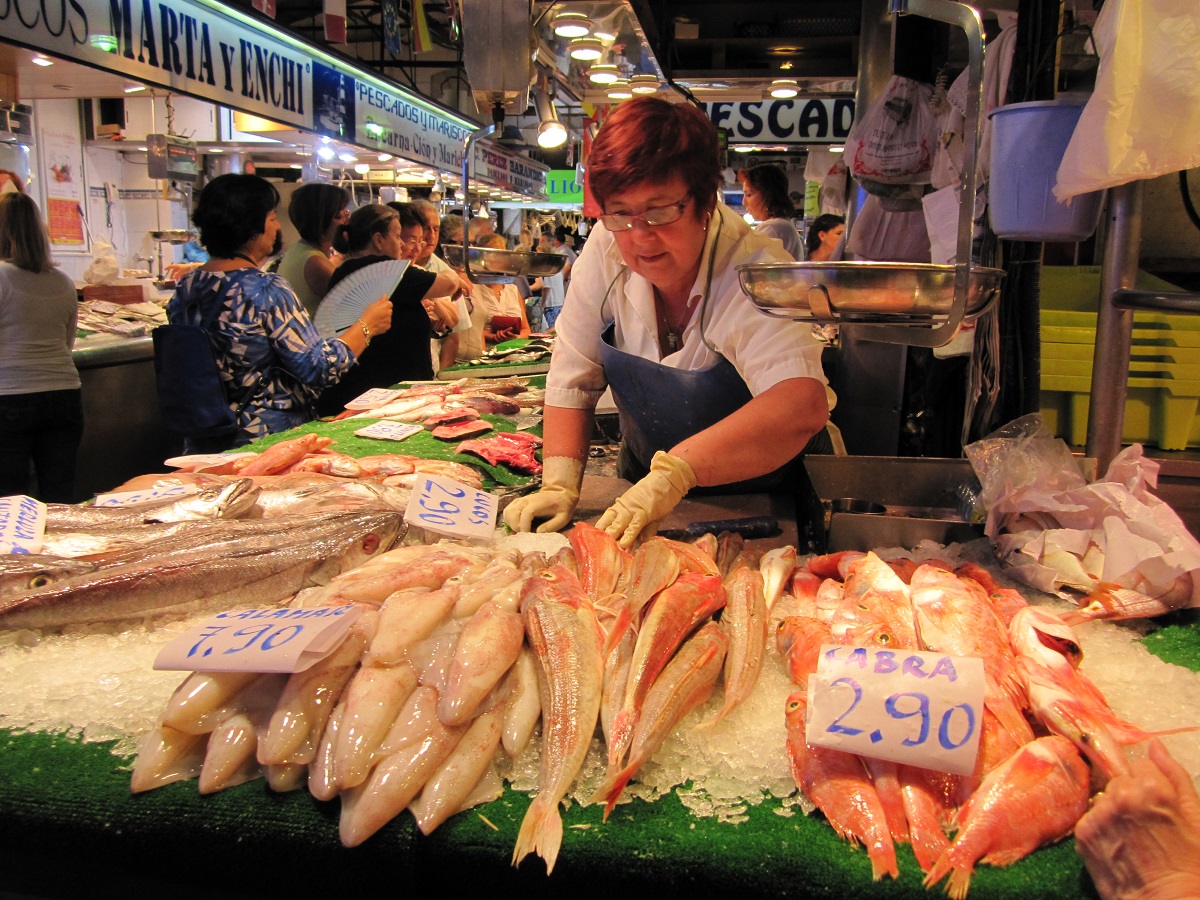
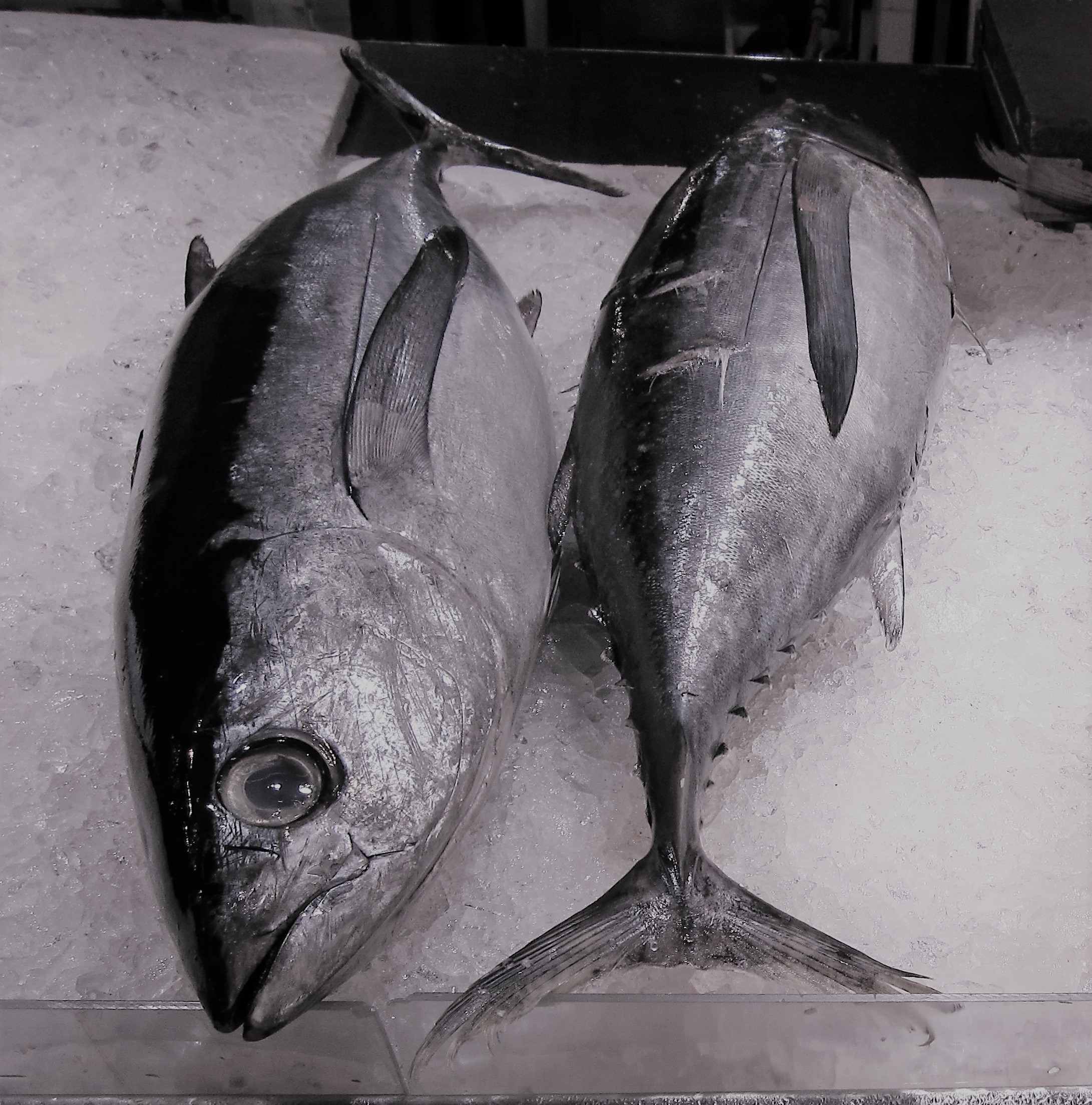
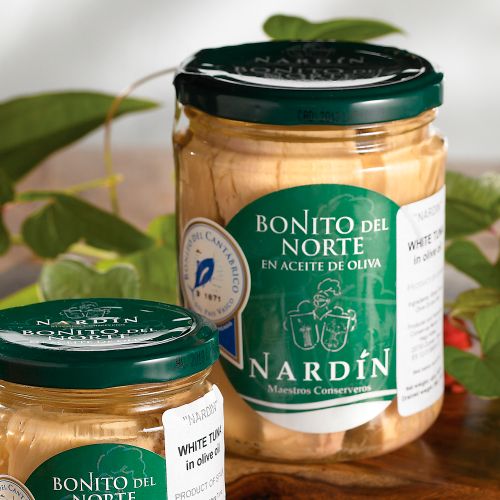 bonito is white and has a smoother texture than other tuna, and an exquisite taste. There's nothing like enjoying grilled bonito on a summer evening with outside seating at a local restaurant. Bonito is also packed in olive oil and sold in cans and jars. It retains its flavor well and is a top-quality product.
bonito is white and has a smoother texture than other tuna, and an exquisite taste. There's nothing like enjoying grilled bonito on a summer evening with outside seating at a local restaurant. Bonito is also packed in olive oil and sold in cans and jars. It retains its flavor well and is a top-quality product.
Odds are you haven't heard of this tea, although it is as popular in parts of South America as coffee is in the U.S. It is made from the yerba mate plant, a 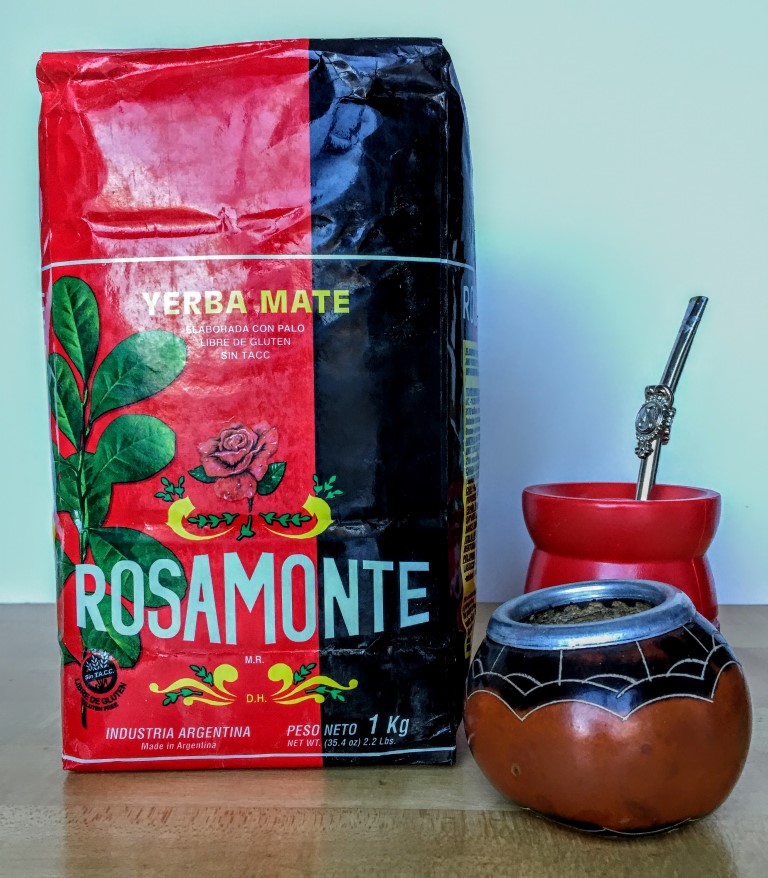
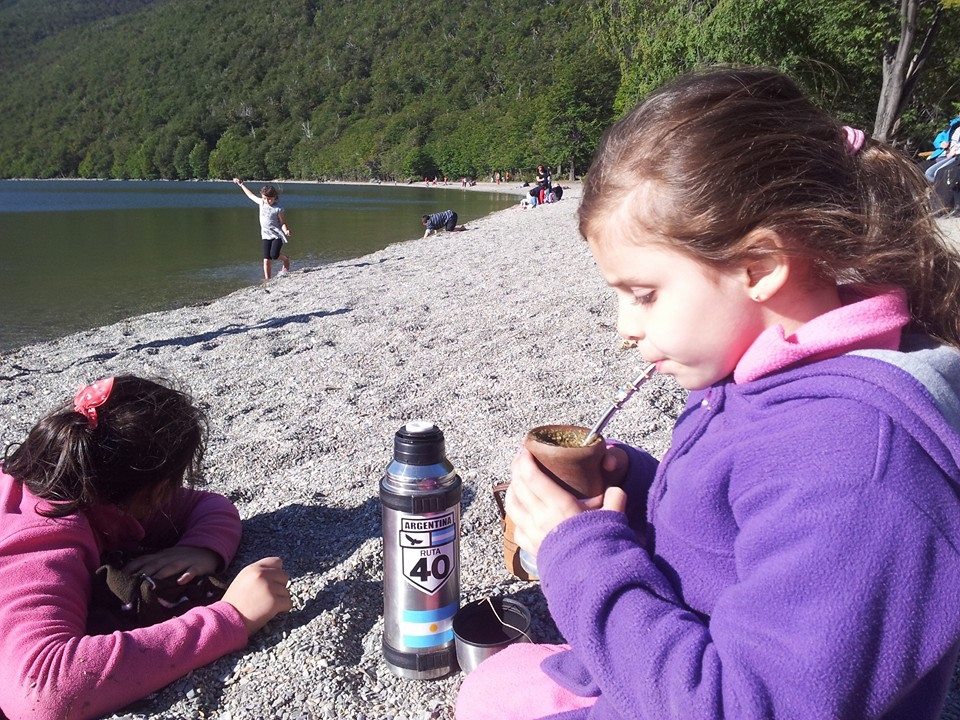
Drinking mate is widely considered to have a number of health benefits. The site fitday.com discusses six: 1) Rich in Antioxidants, 2) Enhances Your Ability to Focus, 3) Enhances Physical Endurance, 4) Aids Digestion, 5) Helps You Control Your Weight and 6) Supports Cardiovascular Health. Like coffee, mate contains caffeine and so has a pick-me-up effect. It is known to reduce feelings of hunger and believed to boost the immune system and have anti-cancer properties. Click the YouTube play button below to see a video about yerba mate.
Can mate make you happier? The website sanjuan8.com includes an article (in Spanish) on this topic.
Yerba mate and drinks made from it can be found in health and natural food stores. Put it on your shopping list.
Some consider Pastel de Choclo, or corn pie, to be Chile's national dish. While students learn that corn in Spanish is maiz, the word choclo means 'ear of corn' and comes from the Quechua word choccllo. In Mexico, it's called elote, from the Nahuatil word elotl.
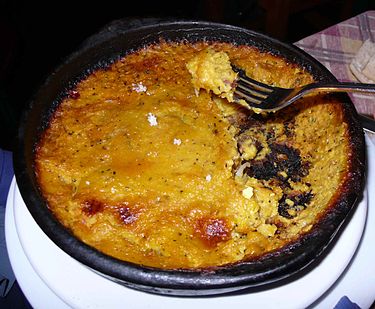 There are many different variations of this dish; often it includes beef or chicken along with raisins, olives, onions and pieces of hardboiled egg. Unlike Shepherd's pie, the corn in Pastel de Choclo is grated or otherwise processed until smooth. The ingredients are layered in the dish, with the corn filling on top. It is traditionally served in a shallow, round pottery bowl.
There are many different variations of this dish; often it includes beef or chicken along with raisins, olives, onions and pieces of hardboiled egg. Unlike Shepherd's pie, the corn in Pastel de Choclo is grated or otherwise processed until smooth. The ingredients are layered in the dish, with the corn filling on top. It is traditionally served in a shallow, round pottery bowl.
If you can't travel right away to South America to try Pastel de Choclo, try making your own. Here's a recipe to try: https://www.food.com/recipe/chilean-pastel-de-choclo-139426
So when you're at the supermarket (supermercado) in the U.S. and you pick up just about any food product, somewhere on the package you'll find the "Nutritional Facts" box. There's a lot of information there but it's hardly useful unless you know quite a bit about diet and nutrition.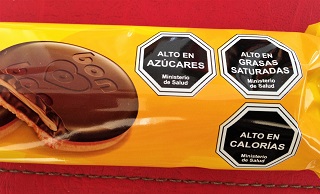 In contrast, take a look at this photo from a package of cookies (galletas) in Chile. Food packages in Chile have these alerts (avisos) when a product is high in sugar, saturated fats, sodium or calories. This way, you know right away and then it's your decision, but an informed one. Chile's labeling law was aimed at its obesity related health problems, associated with unhealthy diets. Chile however does not have a GMO labeling law. Translated, the labels say "high in sugars," "high in saturated fats," and "high in calories."
In contrast, take a look at this photo from a package of cookies (galletas) in Chile. Food packages in Chile have these alerts (avisos) when a product is high in sugar, saturated fats, sodium or calories. This way, you know right away and then it's your decision, but an informed one. Chile's labeling law was aimed at its obesity related health problems, associated with unhealthy diets. Chile however does not have a GMO labeling law. Translated, the labels say "high in sugars," "high in saturated fats," and "high in calories."
Quinoa - the South American Superfood
Do you know about quinoa, the grain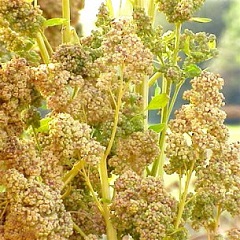 from South America? This is not some weird health veggie that people eat just because nutritious; it's also delicious and versatile. This grain was first domesticated thousands of years ago by indigenous peoples from the Andean region of South America, including parts of Peru, Bolivia, Ecuador and Colombia. Quinoa is in the same plant family as spinach and beets, but it's the seeds of the plant that are harvested. As such, it is not a cereal grain such as wheat and does not contain gluten. It is one of the few plant-based sources of complete protein, containing all 9 essential amino acids, plus antioxidants and other nutrients.
from South America? This is not some weird health veggie that people eat just because nutritious; it's also delicious and versatile. This grain was first domesticated thousands of years ago by indigenous peoples from the Andean region of South America, including parts of Peru, Bolivia, Ecuador and Colombia. Quinoa is in the same plant family as spinach and beets, but it's the seeds of the plant that are harvested. As such, it is not a cereal grain such as wheat and does not contain gluten. It is one of the few plant-based sources of complete protein, containing all 9 essential amino acids, plus antioxidants and other nutrients. 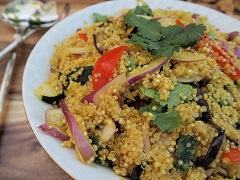 While some quinoa is commercially produced in the U.S., the majority still comes from Peru and Bolivia. It is cooked similarly to rice and can be used in lots of different dishes. We like to make veggie burgers with quinoa, black beans and some other veggies. It also combines well with fresh veggies from the garden. A salad made with quinoa is shown in the photo. You can find many recipes online, including at the websites of foodnetwork.com and ancientharvest.com
While some quinoa is commercially produced in the U.S., the majority still comes from Peru and Bolivia. It is cooked similarly to rice and can be used in lots of different dishes. We like to make veggie burgers with quinoa, black beans and some other veggies. It also combines well with fresh veggies from the garden. A salad made with quinoa is shown in the photo. You can find many recipes online, including at the websites of foodnetwork.com and ancientharvest.com
Costa Rica is one of the most popular Latin American places to visit and for good reason. This relatively small country has everything from mountains and active volcanos to beaches, a varied climate and an amazing diversity of wildlife. There is something to do for all tastes, as you can easily discover from the official tourism website www.visitcostarica.com.
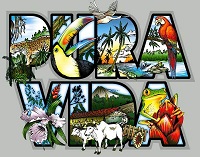 What’s more, you’ll find friendly people who live by the country’s hallmark phrase pura vida. Spanish for "pure life," pura vida is really a lifestyle, one of enjoying life to its fullest, appreciating the good things, being carefree and optimistic. The phrase is used frequently in conversation; what better way to keep "walking the talk!" Learn to say it and live it the way the Ticos (Costa Ricans) do.
What’s more, you’ll find friendly people who live by the country’s hallmark phrase pura vida. Spanish for "pure life," pura vida is really a lifestyle, one of enjoying life to its fullest, appreciating the good things, being carefree and optimistic. The phrase is used frequently in conversation; what better way to keep "walking the talk!" Learn to say it and live it the way the Ticos (Costa Ricans) do.
You may be interested in reading more at the website of a Boston couple who 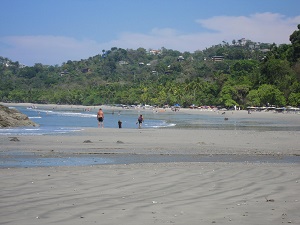 quit their jobs, packed up and moved there. You’ll find some helpful info for planning your visit. Costa Rica is popular, so be sure to plan ahead for the best selection of flights and hotels.
quit their jobs, packed up and moved there. You’ll find some helpful info for planning your visit. Costa Rica is popular, so be sure to plan ahead for the best selection of flights and hotels.
A number of our students love Costa Rica, and our own vacation there was wonderful. Our only regret was not being able to stay longer and see more of this beautiful country!
Every year on May 5, we ask our students about Cinco de Mayo. Do you know the significance of this day? 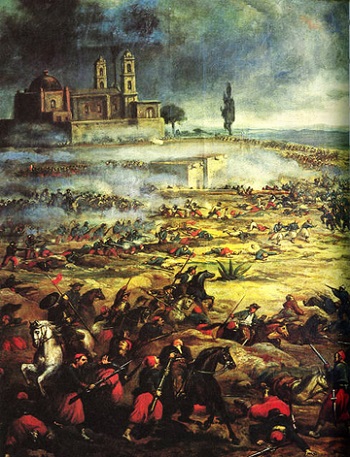 Here's a short history. Cinco de Mayo of course means "May 5th" in Spanish and commemorates the victory of the Mexican army, lead by General Ignacio Zaragoza, over much more numerous and better equipped French troops, in the Battle of Puebla, 1862. Given what the Mexican forces were up against, this was a great victory and a unifying source of pride during difficult times. Mexican president Benito Juárez then declared that May 5 would be a national holiday to commemorate the battle. This victory was however short-lived as France came back with greater forces to conquer Mexico the following March, finally leaving five years later. If Mexico had not won the Battle of Puebla, France may have helped the Confederacy during the U.S. Civil War and affected the outcome.
Here's a short history. Cinco de Mayo of course means "May 5th" in Spanish and commemorates the victory of the Mexican army, lead by General Ignacio Zaragoza, over much more numerous and better equipped French troops, in the Battle of Puebla, 1862. Given what the Mexican forces were up against, this was a great victory and a unifying source of pride during difficult times. Mexican president Benito Juárez then declared that May 5 would be a national holiday to commemorate the battle. This victory was however short-lived as France came back with greater forces to conquer Mexico the following March, finally leaving five years later. If Mexico had not won the Battle of Puebla, France may have helped the Confederacy during the U.S. Civil War and affected the outcome.
Today, Cinco de Mayo is a regional holiday in Mexico. It is celebrated to a larger extent in parts of the U.S. where there are significant populations of Mexican heritage. Festivities often include Mexican food, music, folk dancing, and parades.
Chipá are cheese bread snacks, about the size of a golf ball. 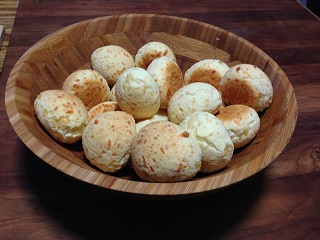 If you haven't tried them, well, you should. Enjoy them for breakfast or as an afternoon snack. They are best eaten right after being made, and no one eats just one.
If you haven't tried them, well, you should. Enjoy them for breakfast or as an afternoon snack. They are best eaten right after being made, and no one eats just one.
Chipá were originally prepared many years ago by the Guarani, an indigenous people who live in Paraguay and parts of Uruguay, northern Argentina, southern Brazil and Bolivia.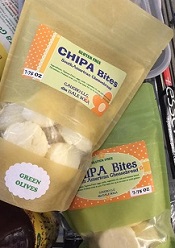
The word chipa comes from the Guarani language. The Guarani made chipá with tapioca (a starch flour from the cassava root; mandioca in Spanish) and water.
Recipes vary today but chipá is typically made with tapioca starch and cheese....we use parmesan and lots of it. Since tapioca is not a grain, chipá are gluten-free.
You can find chipá for sale at the Healthy Living Market in South Burlington; they are sold frozen, ready to bake and eat fresh (see photo at right). If you would like to try making your own, recipes can be found online. Click here for one.
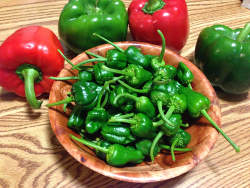
The pepper was brought to Spain in the 18th century from South America and was cultivated by Franciscans at a monastery near the town of Padrón in Galicia, Spain. They can now be found in parts of the US, and you can also grow your own by purchasing the seeds, such as from Johnny's Selected Seeds. 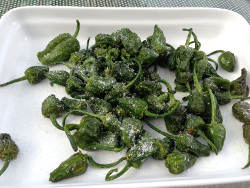
They are picked while small (1-1.5 inches in length or so), fried or sautéed whole in oil, and then served sprinkled with coarse salt. Better yet, travel to Spain during the summer and enjoy the real thing as an appetizer or at tapas restaurants.
As they say in Spain, "Unos pican y otros no."
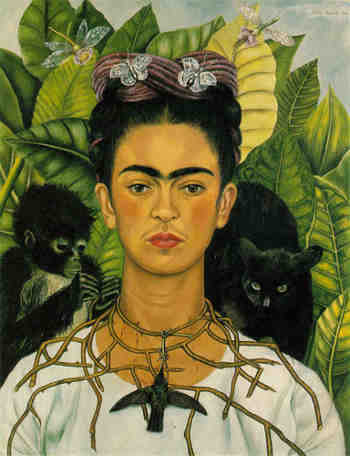 July 13, 2014 marks 60 years since the passing of Frida Kahlo, the Mexican artista famous for her painfully personal self-portraits. She was born in Coyocoán, Mexico City in 1907. As an adult, Frida lived an active and controversial life as a painter, political activist and feminist. This is hard to imagine, given the obstacles she had to overcome. She contracted polio at age 6, and then at age 18 she was involved in a bus-trolley car collision that broke her spinal column (along with other injuries). She spent considerable time either in the hospital or bedridden, suffering considerable pain for the rest of her life. She took up painting to occupy her time, painting from her own experiences. Her work included many self-portraits and images that captured the pain she endured during her life, many of which are also painful to view. She eventually regained her ability to walk. In 1929 she married Mexican painter Diego Rivera, who encouraged her artwork, although their relationship later became very tumultuous. After suffering deteriorating health, Frida died at age 47, possibly from suicide. Shortly before her death, she wrote in her diary, "I hope the exit is joyful and I hope never to return" ("Espero alegre la salida -- y espero no volver jamás"). The award-winning 2002 film Frida tells the story of her life, with Salma Hayak starring as the artist.
July 13, 2014 marks 60 years since the passing of Frida Kahlo, the Mexican artista famous for her painfully personal self-portraits. She was born in Coyocoán, Mexico City in 1907. As an adult, Frida lived an active and controversial life as a painter, political activist and feminist. This is hard to imagine, given the obstacles she had to overcome. She contracted polio at age 6, and then at age 18 she was involved in a bus-trolley car collision that broke her spinal column (along with other injuries). She spent considerable time either in the hospital or bedridden, suffering considerable pain for the rest of her life. She took up painting to occupy her time, painting from her own experiences. Her work included many self-portraits and images that captured the pain she endured during her life, many of which are also painful to view. She eventually regained her ability to walk. In 1929 she married Mexican painter Diego Rivera, who encouraged her artwork, although their relationship later became very tumultuous. After suffering deteriorating health, Frida died at age 47, possibly from suicide. Shortly before her death, she wrote in her diary, "I hope the exit is joyful and I hope never to return" ("Espero alegre la salida -- y espero no volver jamás"). The award-winning 2002 film Frida tells the story of her life, with Salma Hayak starring as the artist.
Latin American Cuisine: Arepas
If you travel to Colombia, you will almost certainly enjoy eating arepas. The arepa, a round flatbread made of corn flour, is a plato tipico (typical dish) of Colombia and Venezuela. Arepas come in many different styles, varying from plain, to cheese mixed into the dough, or those that are split in half and stuffed with various fillings (as in the photo) to form a sandwich of sorts. Common fillings include meat, cheese, and vegetables. One of our Colombian friends made arepas for us, using a filling of tomatoes, onions, mayonnaise and tomato sauce. A hearty Colombian breakfast may include fruit and an arepa along with some good Colombian coffee, but they’re good any time.
Want to make arepas? You can find arepa flour, called masarepas, in the international section of many supermarkets. One of the common brands is Goya. The package includes instructions for preparing dough and cooking the cakes. You can also find instructions and recipes online, such as
www.seriouseats.com/2012/04/latin-american-cuisine-colombian-arepas.html
www.mycolombianrecipes.com/recipes/main-dishes/arepas-tamales
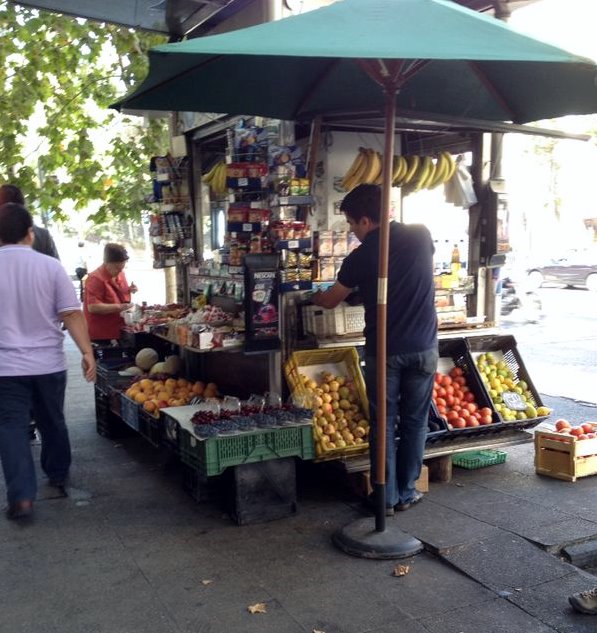 Small local markets and street vendors are a part of everyday life in Latin America. We especially like the fruit stands. Everything is so fresh and you are greeted by a wonderful, fruity aroma as you look over the neatly arranged fruits. But the real treat is the unbeatable taste, which you may find to be surprisingly different from U.S. supermarket fruit. Remember, what is exotic, tropical or just unavailable in the U.S. may be local to the area you are visiting. And you’re likely to enjoy fruits you’ve never seen before.
Small local markets and street vendors are a part of everyday life in Latin America. We especially like the fruit stands. Everything is so fresh and you are greeted by a wonderful, fruity aroma as you look over the neatly arranged fruits. But the real treat is the unbeatable taste, which you may find to be surprisingly different from U.S. supermarket fruit. Remember, what is exotic, tropical or just unavailable in the U.S. may be local to the area you are visiting. And you’re likely to enjoy fruits you’ve never seen before. 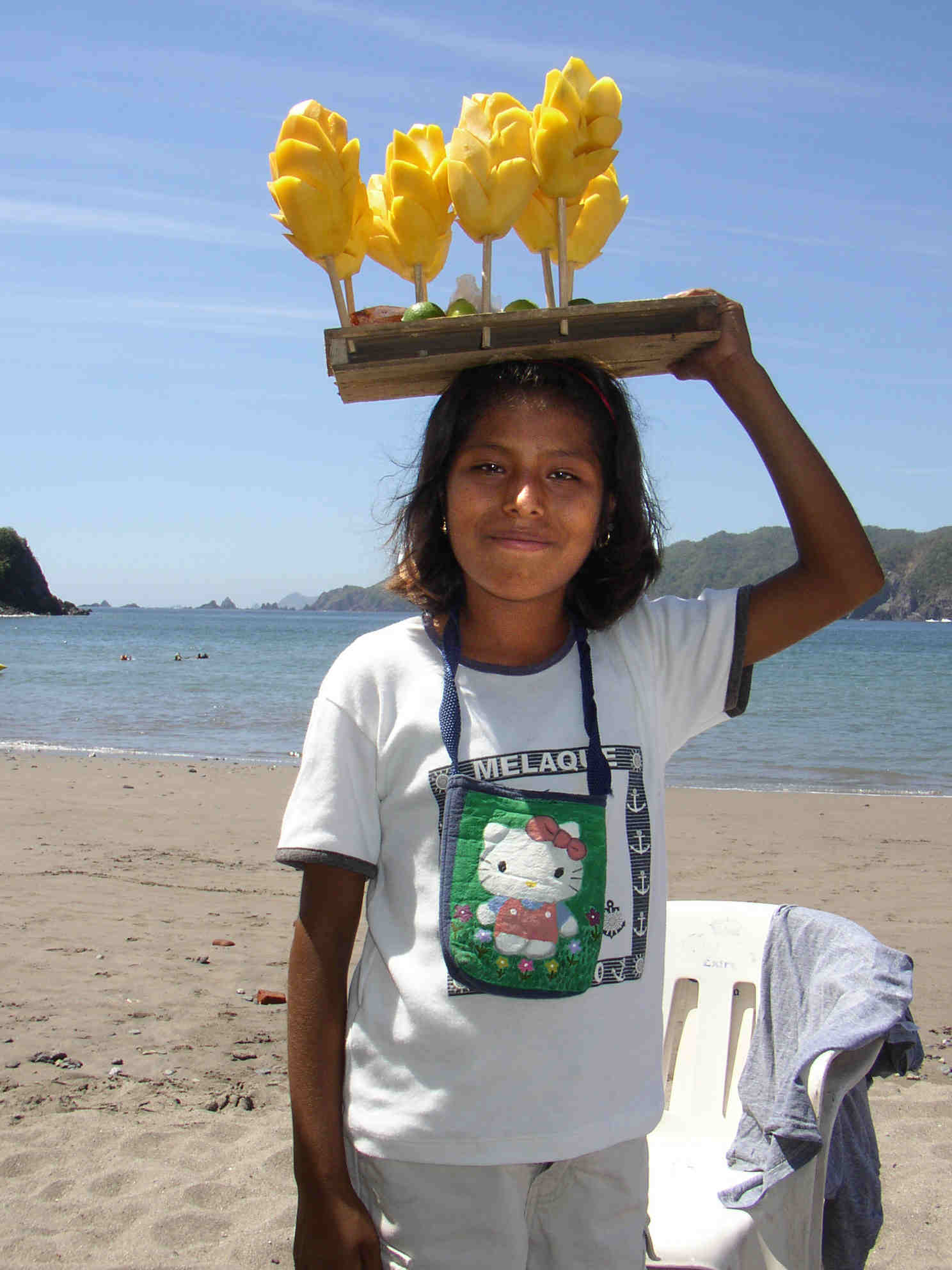 Nothing beats a refreshing smoothie (in Spanish: batido or licuado) made from fresh local fruit, so be sure to keep an eye out for the local smoothie shop. You may also find street vendors selling various fruit snacks. In some parts of Mexico, vendors walk the beaches selling ready-to-eat mangoes on a stick. You can add a bit of lime juice and chili powder if you like. So if you are traveling in Central or South America, be sure to enjoy the fruit!
Nothing beats a refreshing smoothie (in Spanish: batido or licuado) made from fresh local fruit, so be sure to keep an eye out for the local smoothie shop. You may also find street vendors selling various fruit snacks. In some parts of Mexico, vendors walk the beaches selling ready-to-eat mangoes on a stick. You can add a bit of lime juice and chili powder if you like. So if you are traveling in Central or South America, be sure to enjoy the fruit!
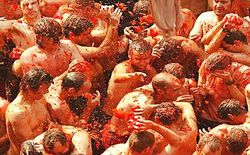 Spain is definitely a cool place to visit. One reason is to get in on some of the great, even quirky, festivals. Perhaps the most famous of these is the Running of the Bulls in Pamplona (el encierro). But, have you heard of a festival called La Tomatina? It is celebrated the last Wednesday in August in the town of Buñol, in the province of Valencia. This is basically an organized tomato fight, held for fun. The week-long festival also includes other activities, including a paella cooking contest and the palo jamón, which involves climbing a pole greased with soap, with a ham on top. Once someone is able to climb the pole and bring down the ham, the tomato throwing begins, by one estimate more than 240,000 pounds worth. Yes there are some rules, like tomatoes must be squashed before being thrown, and no ripping other's clothes. The town now limits the fight to 5,000 locals and 15,000 foreigners so things don't get a little crazy! Read more about it at https://en.wikipedia.org/wiki/La_Tomatina
Spain is definitely a cool place to visit. One reason is to get in on some of the great, even quirky, festivals. Perhaps the most famous of these is the Running of the Bulls in Pamplona (el encierro). But, have you heard of a festival called La Tomatina? It is celebrated the last Wednesday in August in the town of Buñol, in the province of Valencia. This is basically an organized tomato fight, held for fun. The week-long festival also includes other activities, including a paella cooking contest and the palo jamón, which involves climbing a pole greased with soap, with a ham on top. Once someone is able to climb the pole and bring down the ham, the tomato throwing begins, by one estimate more than 240,000 pounds worth. Yes there are some rules, like tomatoes must be squashed before being thrown, and no ripping other's clothes. The town now limits the fight to 5,000 locals and 15,000 foreigners so things don't get a little crazy! Read more about it at https://en.wikipedia.org/wiki/La_Tomatina
Founded in 1883 in Chile, Concha y Toro is one of the most important wineries in the world. Their oldest cellars and vineyards are located in 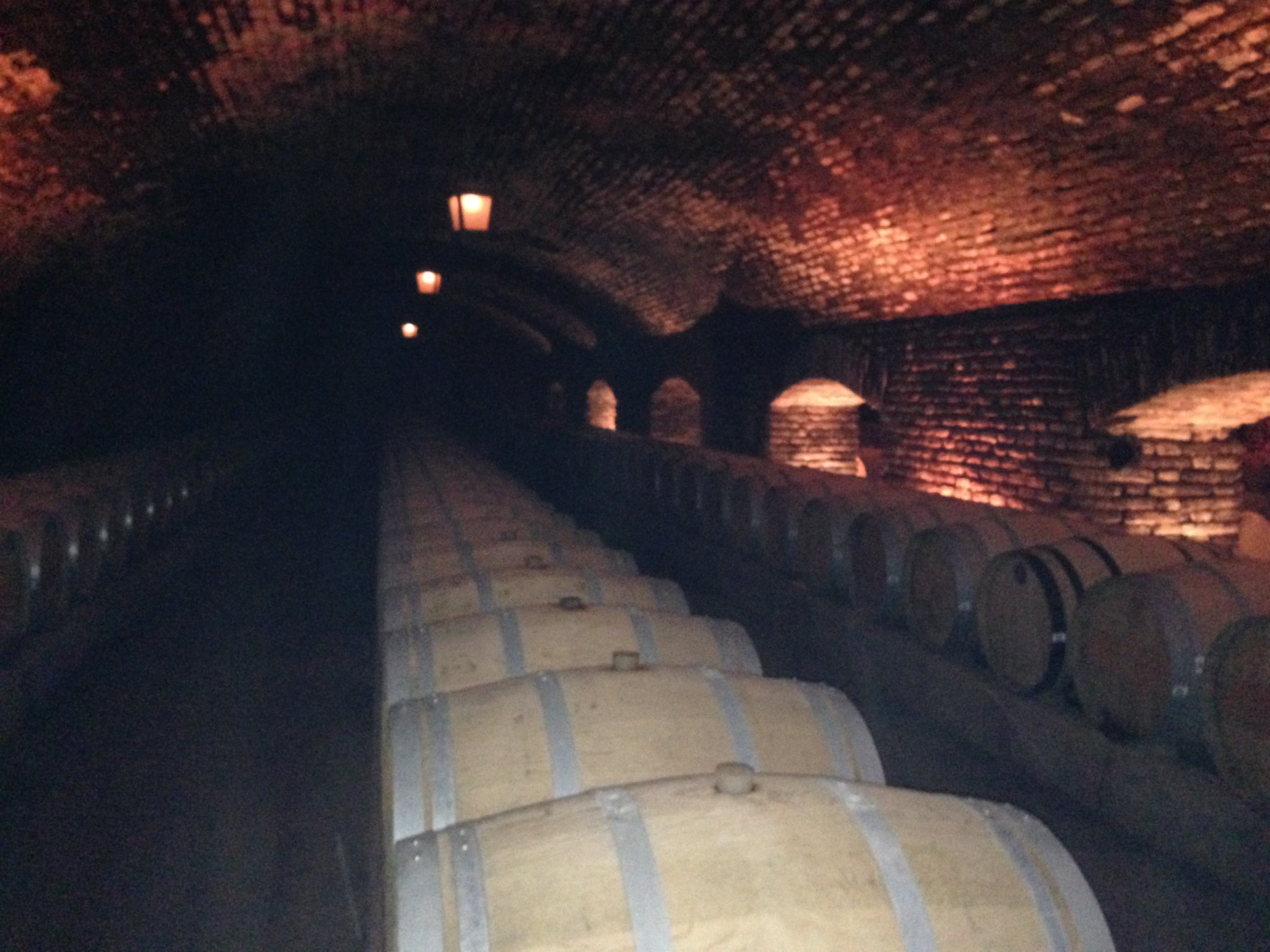
The photo shows a larger part of the cellar adjacent to the where the private reserve was historically held. If you visit Chile, you can tour the winery and cellars for yourself…if you dare.
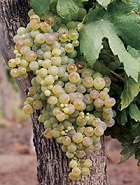 If you enjoy Chardonnay, you owe it to yourself to try Torrontés. Argentina’s wine culture began in the 16th century when the Spanish explored and settled South America, bringing with them the vines of their favorite wine grape varieties. The best known wine from Argentina is Malbec, a flavorful red wine. Argentina’s other signature wine is Torrontés, a refreshing, aromatic white wine considered to be a wholly Argentine variety because it is produced almost nowhere else.
If you enjoy Chardonnay, you owe it to yourself to try Torrontés. Argentina’s wine culture began in the 16th century when the Spanish explored and settled South America, bringing with them the vines of their favorite wine grape varieties. The best known wine from Argentina is Malbec, a flavorful red wine. Argentina’s other signature wine is Torrontés, a refreshing, aromatic white wine considered to be a wholly Argentine variety because it is produced almost nowhere else. 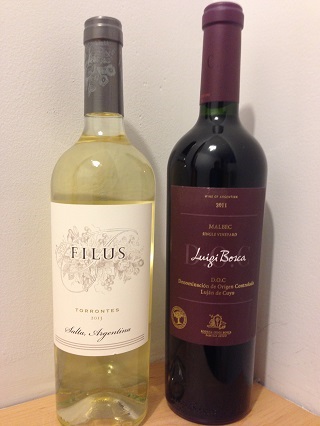
The origin of Torrontés is uncertain, and it is not the same as a Spanish wine from Galicia labeled with the same name. It is grown in some of the highest vineyards in the world in the Salta region of Argentina. It makes an excellent start to a meal and pairs well with delicate flavors such as fish and other seafood, but also with spicier dishes including Thai or Chinese. Step up from Chardonnay and give it a try.
Malbec is a red grape variety that originated in France and was introduced to Argentina in 1868. Since that time, production in France has decreased in favor of other varieties, but increased substantially in Argentina. Three quarters of all Malbec is produced in Argentina, and it is considered to be the signature Argentine wine. Perhaps the best Malbec comes from Mendoza's high altitude regions, which are particularly well suited for bringing out the best in this variety. The variety is grown in a number of other countries, but to a much lesser extent and often for use in blended wines.
Argentine Malbec is a full-bodied wine with flavors of plum and black cherry with gentle notes of cocoa and vanilla. It pairs well with strong flavored foods such as red meat, 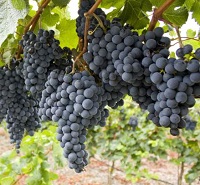 dark meat poultry, roasted pork, mushroom, roasted red pepper, potato, pizza, pungent cheeses and various spicy dishes (think sage, rosemary, cumin, pepper). In Argentina, it is commonly paired with grilled meats. Yum.
dark meat poultry, roasted pork, mushroom, roasted red pepper, potato, pizza, pungent cheeses and various spicy dishes (think sage, rosemary, cumin, pepper). In Argentina, it is commonly paired with grilled meats. Yum.
If you enjoy wine and haven't tried Malbec, it's time you did.
Carmenere – Lost and Found in Chile
Carmenere is a dark-skinned red grape variety originally from the vineyards of Bordeaux, France. It disappeared from European vineyards in the mid-1800s and was believed lost, only to reappear 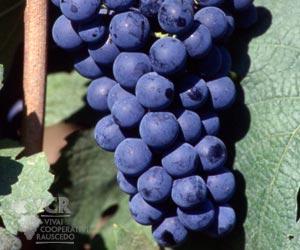 among Chile’s Merlot vines a hundred years later. In the mid-18th Century, the aphid-like phylloxera arrived in Europe from North America. This sap-sucking insect feeds on the roots of the plant, and Carmenere vines are particularly susceptible. As a result, the variety was abandoned in Europe. However, prior to the arrival of phylloxera, Chilean vignerons had taken cuttings from vineyards in the Bordeaux region. These stocks were believed at the time to be Merlot, and it was not until 1994 when DNA research confirmed that the Carmenere variety also existed in Chile. Chile then began making wine with 100% Carmenere, and the variety has since become Chile's signature wine.
among Chile’s Merlot vines a hundred years later. In the mid-18th Century, the aphid-like phylloxera arrived in Europe from North America. This sap-sucking insect feeds on the roots of the plant, and Carmenere vines are particularly susceptible. As a result, the variety was abandoned in Europe. However, prior to the arrival of phylloxera, Chilean vignerons had taken cuttings from vineyards in the Bordeaux region. These stocks were believed at the time to be Merlot, and it was not until 1994 when DNA research confirmed that the Carmenere variety also existed in Chile. Chile then began making wine with 100% Carmenere, and the variety has since become Chile's signature wine.
Historic and modern, traditional local dishes to cutting edge creative cuisine, appealing small shops to modern malls: Santiago has a lot to offer. 
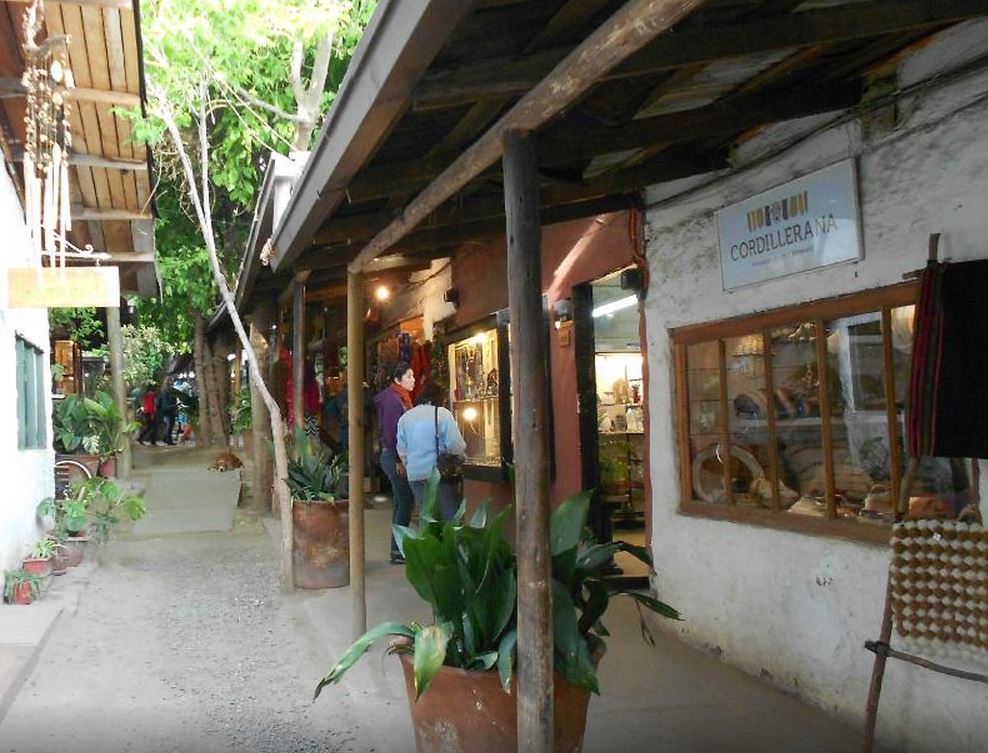
Ciclismo de Montaña: Since Santiago has the Andes mountains close at hand as well as  some other hills (cerros) even closer, it should come as no surprise that there are some great mountain biking oppotunities. You can find guides who speak English, although they are happy to speak Spanish with you. Click the photo at left to watch the video of one of our advanced students being interviewed by his Chileno guide.
some other hills (cerros) even closer, it should come as no surprise that there are some great mountain biking oppotunities. You can find guides who speak English, although they are happy to speak Spanish with you. Click the photo at left to watch the video of one of our advanced students being interviewed by his Chileno guide.
Read more:
Summer at Valle Nevado -- www.vallenevado.com/en/summer-at-valle-nevado/
Wines of Chile -- www.winesofchile.org/chilean-wine/

How are Christmas, New Year's and Three Kings Day celebrated in Hispanic culture? There are many unique customs that vary by country and household, but you will always find three things: delicious food, celebratory music and festive gatherings of family and friends. Festivities often begin in mid-December and continue until January 6. At the risk of over-generalizing, we've summarized the traditions below and included related Spanish vocabulary.
Before Christmas: As is the case in most cultures, there are a number of celebrations leading up to Christmas. It is common to see a nativity scene or manger (el pesebre or el nacimiento) and some are quite elaborate. Instead of Santa Claus, Latino children will write letters to baby Jesus (la carta al niño Dios). Christmas carols (los villancicos de Navidad) often include songs that have been passed down from generation to generation. Las Posadas, a re-enactment of Mary and Joseph’s journey from Nazareth to Bethlehem and their search of shelter, are popular in Mexico (see also Celebrating Las Posadas). In Puerto Rico there are parrandas, in which people go house to house, singing Christmas songs and playing traditional instruments.
Christmas Eve & Christmas: Of course, "Merry Christmas" in Spanish is ¡Feliz Navidad! Christmas eve (Nochebuena) is celebrated rather than Christmas Day. It includes a special dinner of traditional foods (la cena de Nochebuena) with family and close friends. For Catholics, Nochebuena includes a Midnight mass (Misa del Gallo). Gifts are also usually exchanged on Nochebuena. As you can imagine, this is not a night for going to bed early!
New Year's Eve: Nochebuena is usually spent at home with family,  but New Year's Eve (Nochevieja) is often celebrated with friends and by going out (see also Hispanic New Year's Eve Traditions). Fireworks are widely held, and Valparaíso, Chile has the biggest display in South America. People in many Latin American countries make life-sized Año Viejo dolls (literally “Old Year”) that are burned to symbolically leave behind bad things from the old year.
but New Year's Eve (Nochevieja) is often celebrated with friends and by going out (see also Hispanic New Year's Eve Traditions). Fireworks are widely held, and Valparaíso, Chile has the biggest display in South America. People in many Latin American countries make life-sized Año Viejo dolls (literally “Old Year”) that are burned to symbolically leave behind bad things from the old year. 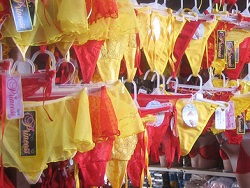 And make sure you are wearing the right color underwear to ring in the new year. Wearing yellow underwear will bring you financial success in the new year; red will bring you love and romance. The Spanish tradition of eating 12 grapes at the stroke of midnight is believed to bring good luck and prosperity in the year ahead.
And make sure you are wearing the right color underwear to ring in the new year. Wearing yellow underwear will bring you financial success in the new year; red will bring you love and romance. The Spanish tradition of eating 12 grapes at the stroke of midnight is believed to bring good luck and prosperity in the year ahead.
Three Kings Day: January 6th is Three Kings Day (el Día de Reyes) or Epiphany. It's the day when the three kings or wise men arrived to present gifts to baby Jesus. It is celebrated throughout Latin America, Spain, and in Hispanic communities of the United States and is usually the day when children receive most of their holiday gifts. While American children often leave cookies and milk for Santa, Latino kids will leave some water and hay for the camels of the Three Kings. (see also Día de Reyes (Three Kings Day))
Review these words to remember:
Nochebuena -Christmas eve
Nochevieja - New Year's Eve
Año Viejo - old year
Christmas is celebrated in all the Hispanic countries, but there are many unique customs that vary by country. 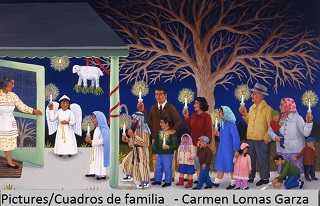 The custom of Las Posadas is celebrated in Central America, parts of the U.S. and in varied forms in other Latin American countries. The celebration takes place for nine nights from December 16 to Christmas Eve (La Noche Buena). Las Posadas are a re-enactment of Mary and Joseph’s journey from Nazareth to Bethlehem and their search of shelter – hence the word posada which is Spanish for lodging or shelter. Traditionally, a party is held each night in a different neighborhood home. Families and friends gather and walk in a procession as travelers or pilgrims (peregrinos). Children are often dressed as shepherds or angels and adults carry candles. They knock on the door of the host family's house and sing poetic songs (villancicos) asking for shelter.
The custom of Las Posadas is celebrated in Central America, parts of the U.S. and in varied forms in other Latin American countries. The celebration takes place for nine nights from December 16 to Christmas Eve (La Noche Buena). Las Posadas are a re-enactment of Mary and Joseph’s journey from Nazareth to Bethlehem and their search of shelter – hence the word posada which is Spanish for lodging or shelter. Traditionally, a party is held each night in a different neighborhood home. Families and friends gather and walk in a procession as travelers or pilgrims (peregrinos). Children are often dressed as shepherds or angels and adults carry candles. They knock on the door of the host family's house and sing poetic songs (villancicos) asking for shelter. 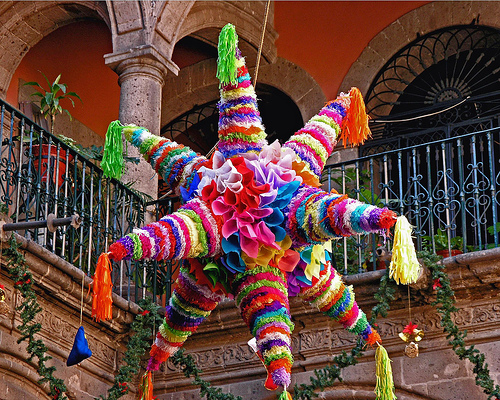 The "innkeepers" sing back and welcome everyone inside for a festive gathering with scrumptious food. In Mexico, the party ends with a piñata in the shape of the Christmas star. The last posada on December 24 is followed by midnight mass (Misa de Gallo).
The "innkeepers" sing back and welcome everyone inside for a festive gathering with scrumptious food. In Mexico, the party ends with a piñata in the shape of the Christmas star. The last posada on December 24 is followed by midnight mass (Misa de Gallo).
The HERDEZ® brand has recipes and advice for how you can host a traditional Mexican Posada or enjoy trying some of the traditional foods.
Hispanic New Year's Eve Traditions
No matter where you are from, New Year’s is always a time to reflect on the past year and plan for the next. In the Hispanic culture, there are quite a few traditions and superstitions for ringing in the New Year. These vary by country, but here are two of the most common.
 Las Doces Uvas (the twelve grapes)
Las Doces Uvas (the twelve grapes)
This Spanish tradition involves eating 12 grapes at the stroke of midnight on New Year’s Eve (Nochevieja), one for each chime (campanada) of the bell tower clock. This practice began in the 1890s but its true origin is uncertain. Some say it came from the French custom of eating grapes along with champagne while others believe that Spanish wine growers started the practice by sharing their grapes in a year of a bountiful harvest. It is believed that this tradition brings good luck and prosperity in the year ahead. The custom has become part of Spanish Christmas festivities, and the clock tower in Puerta del Sol, Madrid is watched on national TV, much like the ball dropping in Times Square. The custom is also followed in other Hispanic cultures, both in the U.S. and other countries. So don’t take any chances with your future; be sure to enjoy this fun tradition and have your grapes ready for the strike of 12!
Lentils for Prosperity

In Italy and much of Latin America, eating lentils as the first meal of the new year is thought to bring prosperity, perhaps due in part to their coin-like form. In some countries, it is customary to also place a handful of lentils in the center of the table or in places you'd like to see lots of money, such as in your purse or pocket. Does it work? Well, it doesn't hurt to try, especially if you're enjoying a nice lentil soup or stew!
The Color of Your Underwear Matters 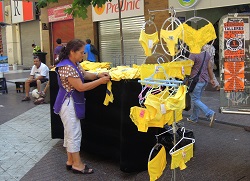
The color of the underwear you wear to ring in the new year may hold major consequences for your life in the year ahead. Is this just a superstition? Maybe it's best to not take any chances. The belief is that wearing yellow underwear you bring you financial success in the new year. Wearing red will bring you love and romance. The choice is yours.
Día de Reyes (Three Kings Day)
January 6th is Three Kings Day, or in Spanish, el Día de Reyes. In the Christian calendar, it is the 12th day after Christmas, known as the Epiphany and the day when the Magi (three kings or wise men) arrived to present gifts to the baby Jesus. 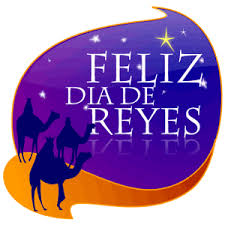 It is celebrated throughout Latin America, Spain, and in Hispanic communities of the United States and is usually the day when children receive most of their holiday gifts.
It is celebrated throughout Latin America, Spain, and in Hispanic communities of the United States and is usually the day when children receive most of their holiday gifts.
Children leave their shoes outside their doors, along with hay and water for the camels of the Three Kings. In the morning, the children find that the Kings had visited and that the camels had refreshed themselves with the hay and water. In addition, by their shoes the Magi have left them wrapped gifts.
Each country celebrates el Día de Reyes somewhat differently, however most observe the custom of eating King's Bread (Roscón de Reyes or Rosca de Reyes), a circular sweet bread decorated with fruit that symbolize the precious gems that adorned the clothing of the Magi.
The poinsettia plant, well known in the United States, originated from the state of Guerrero in Mexico. Long before European colonization, the plants were cultivated by the Aztecs,  who referred to it in their Nahuatl language as 'cuetlaxóchitl' (pronounced kwet-la-SHO-shel). They used the plant for medical purposes, to produce red dyes, and in rituals and offerings.
who referred to it in their Nahuatl language as 'cuetlaxóchitl' (pronounced kwet-la-SHO-shel). They used the plant for medical purposes, to produce red dyes, and in rituals and offerings.
From the 17th century, Franciscan friars in Mexico used the plants in their Christmas celebrations. During the winter of 1828, US botanist Joel Roberts Poinsett came across the plant in a church in Taxco, Guerrero where the monks had used them to decorate a nativity scene. He sent plants and seeds back to his greenhouse in South Carolina. However, the 'poinsettia' named in his honor did not become popular in the United States until much later. Today in Mexico, the plant is known as flor de nochebuena (Christmas Eve flower). The plant blooms in Mexico at the time of the Christmas season, and is very much a part of seasonal celebrations around the world.
Don Quixote, the World's Best Book
 Did you know that 2015 was the 400th anniversary of the completed publication of Miguel de Cervantes’ novel, Don Quixote? Perhaps you have heard of Don Quixote but wonder what the big deal is about a 400-year-old book. The fact is that Don Quixote is considered to be among the best works of fiction ever written. Indeed, in a poll of 100 of the world's top authors, it was voted it to be the best book of all time. Originally written in Spanish, the book has been translated into at least 50 languages. Many of the tales in the novel were no doubt inspired by the realities that Cervantes experienced during his life.
Did you know that 2015 was the 400th anniversary of the completed publication of Miguel de Cervantes’ novel, Don Quixote? Perhaps you have heard of Don Quixote but wonder what the big deal is about a 400-year-old book. The fact is that Don Quixote is considered to be among the best works of fiction ever written. Indeed, in a poll of 100 of the world's top authors, it was voted it to be the best book of all time. Originally written in Spanish, the book has been translated into at least 50 languages. Many of the tales in the novel were no doubt inspired by the realities that Cervantes experienced during his life.
This16th-century story is about an elderly, delusional Spanish nobleman who goes off to live a life of adventure as a chivalrous knight. While his adventures are simple, they have deeper meanings and explore the topics of liberty, justice, inequality, honor and how far one might go in pursuit of one's dreams. Cervantes takes the reader through a labyrinth of fantasy and reality, and we see that Quixote is at times wise and foolish, crazy and astute, a hero and a menace. Certainly he was overly idealistic and impractical, hence the meaning of the word "quixotic" 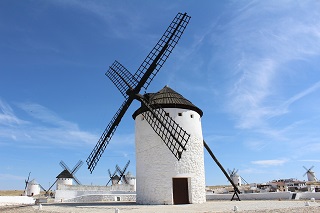 which is based on the book. The idiom "tilting at windmills" comes from a famous chapter in Don Quixote in which our hero comes across a series of windmills which he imagines to be giants that must be vanquished. Perhaps we all face windmills at some point in our lives.
which is based on the book. The idiom "tilting at windmills" comes from a famous chapter in Don Quixote in which our hero comes across a series of windmills which he imagines to be giants that must be vanquished. Perhaps we all face windmills at some point in our lives.


